Proper identification of chanterelle mushrooms is crucial if you want to start harvesting them from the wild. There are poisonous false species; so making a mistake could lead to a miserable intestinal adventure.
Yet don’t let that scare you off! With practice, chanterelle identification will become easier. You’ll start to clearly see how they differ from their look-alikes.
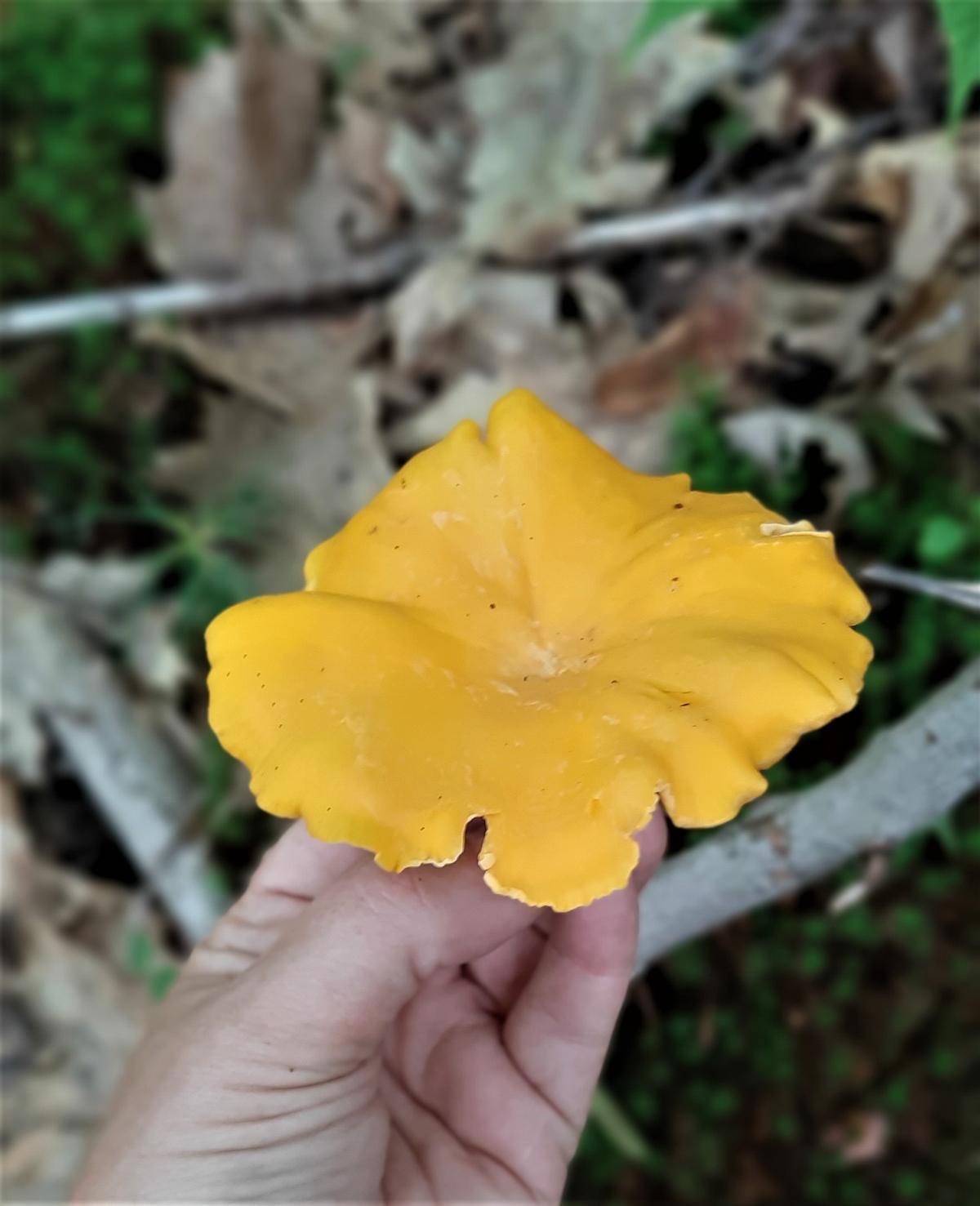
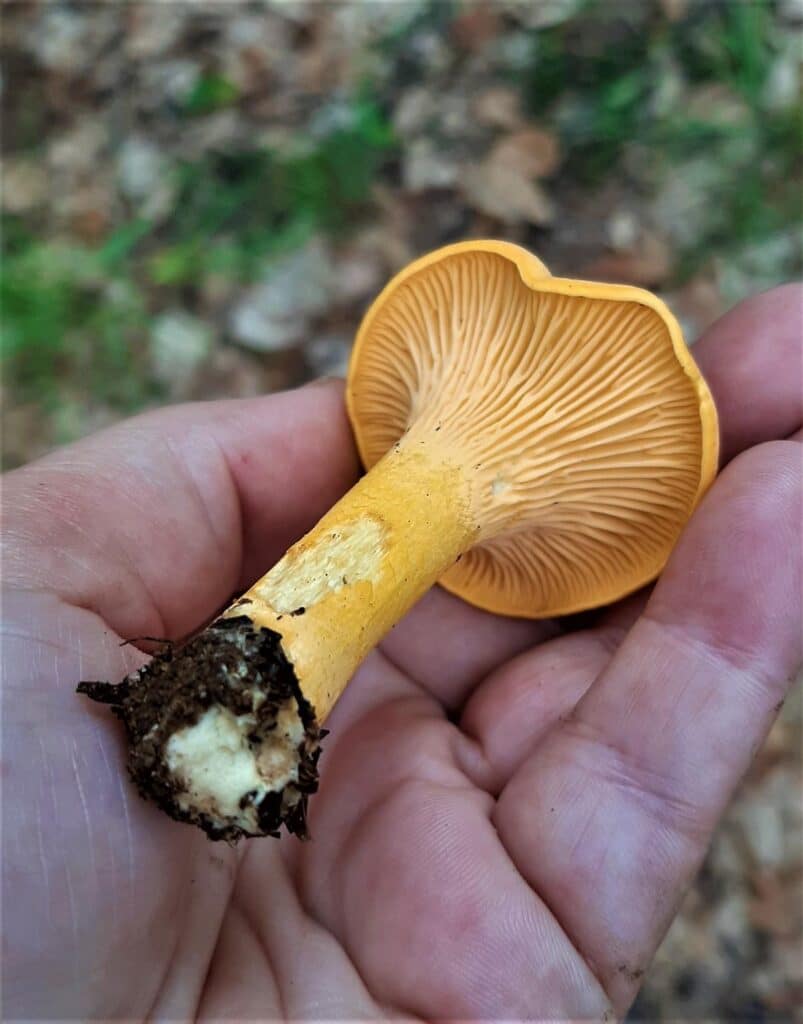
Like so many mushrooms, there is current confusion over chanterelle classification. Mycologists now know that the original Cantharellus cibarius in North America isn’t actually here at all. Instead, there are 20+ different species. For this reason, I’ve avoided using species names on this page, instead just sticking to main chanterelle characteristics.
My final disclaimer is that you should never eat a mushroom-based solely on what you’ve learned online, including this page. Be sure to get some practice with a local expert, and never eat anything you can’t positively identify!
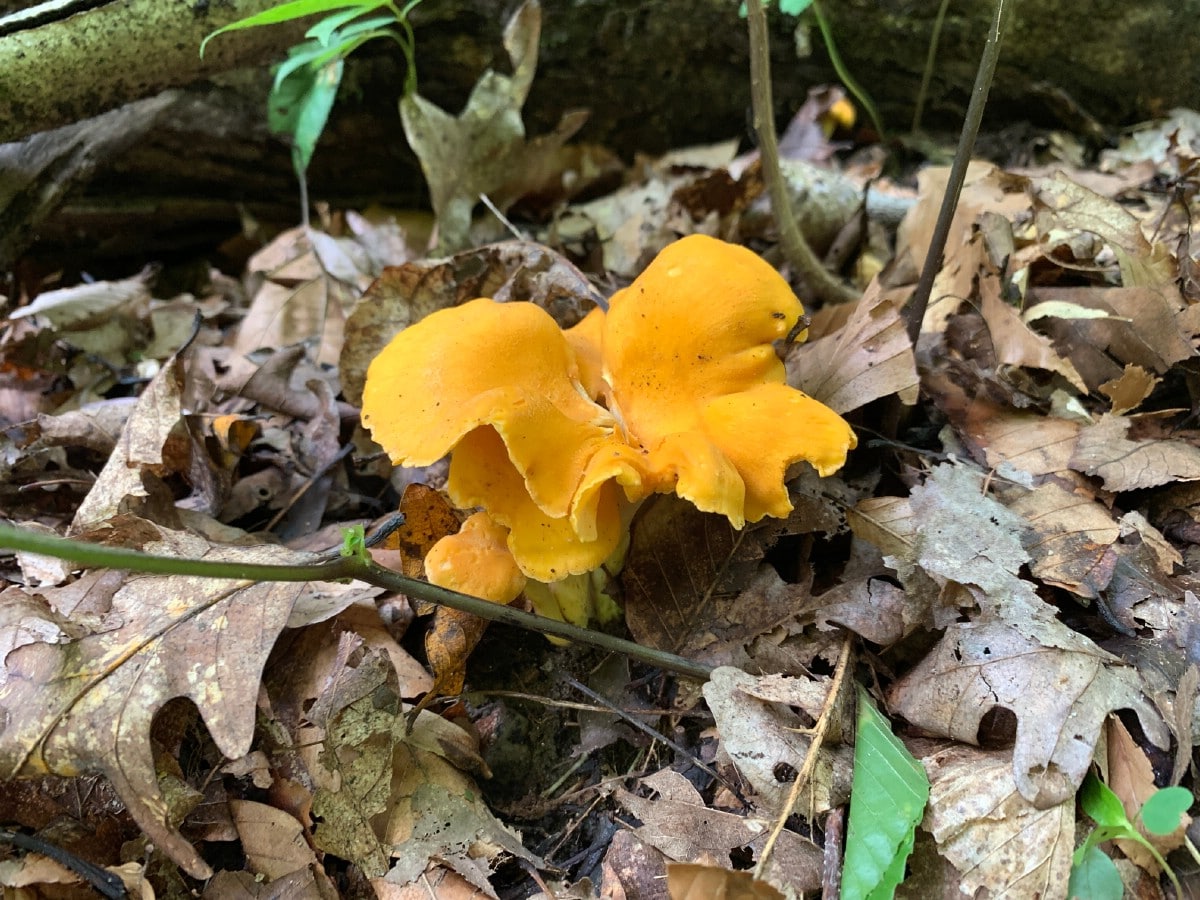
Jump to:
All About Chanterelles
The chanterelle is an edible species of wild mushroom under the Latin name Cantharellus. They are most often golden yellow, but there are also white and bright red species. Golden chanterelles are the most common, though, and are the gems foragers seek in the woods.
Check out our guide to all the chanterelles: Red, White, and Golden Chanterelles of the US: Identification Guide
There are chanterelle species across the globe, from Europe to Africa to Central America, and of course in North America, too. Chanterelles grow singularly in groupings on the forest floor, usually in association with specific tree types.
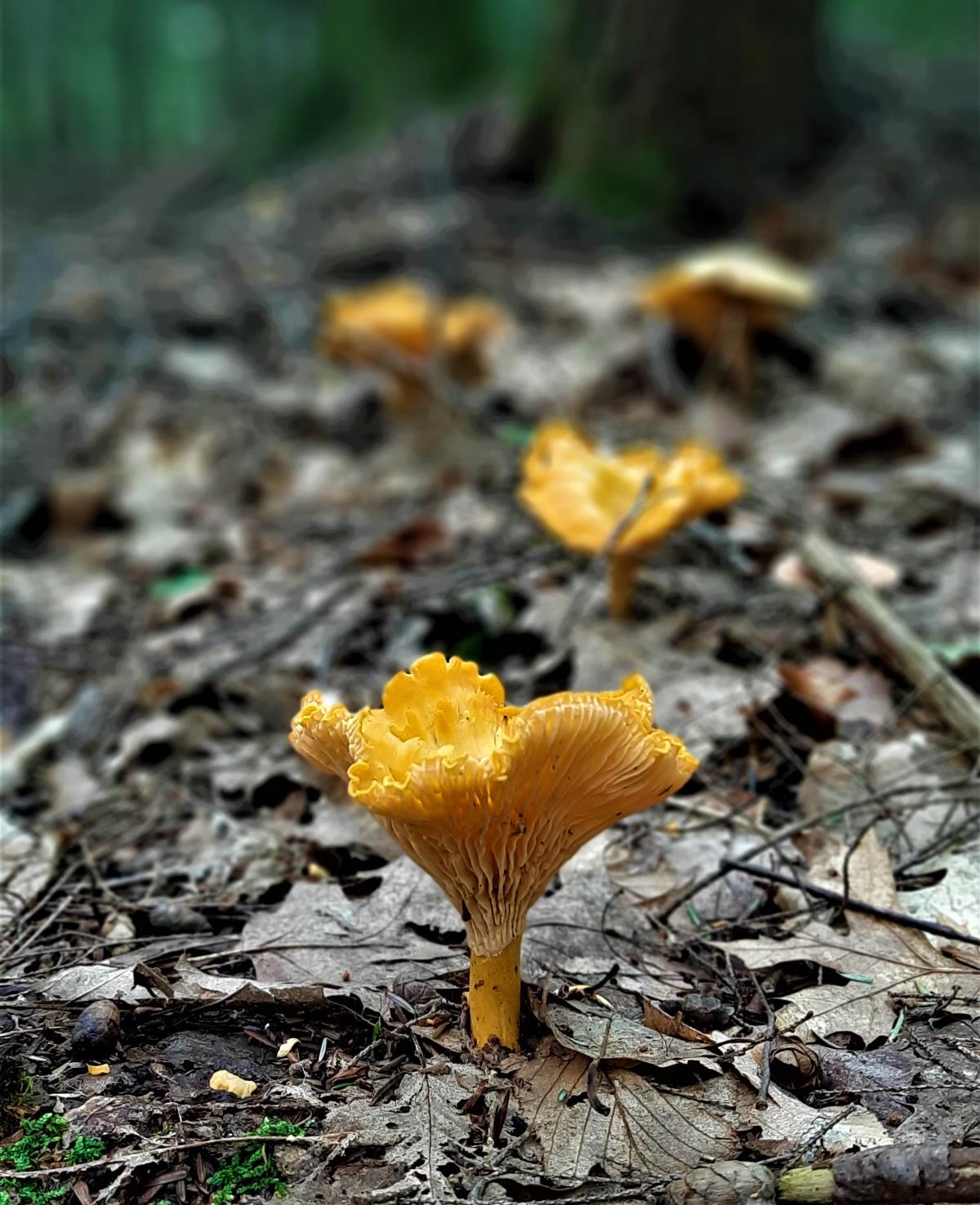
Chanterelles are one of the most expensive mushrooms on the market, and there are a couple of reasons for that. First of all, they are one of the best tasting and, therefore, highly sought after as a culinary delicacy.
Most significantly, though, is that chanterelles can’t be grown commercially, at least not yet. This means that the only way to acquire them is in the forest. Chanterelles also only grow for a few months each year, which increases their exoticism and value.
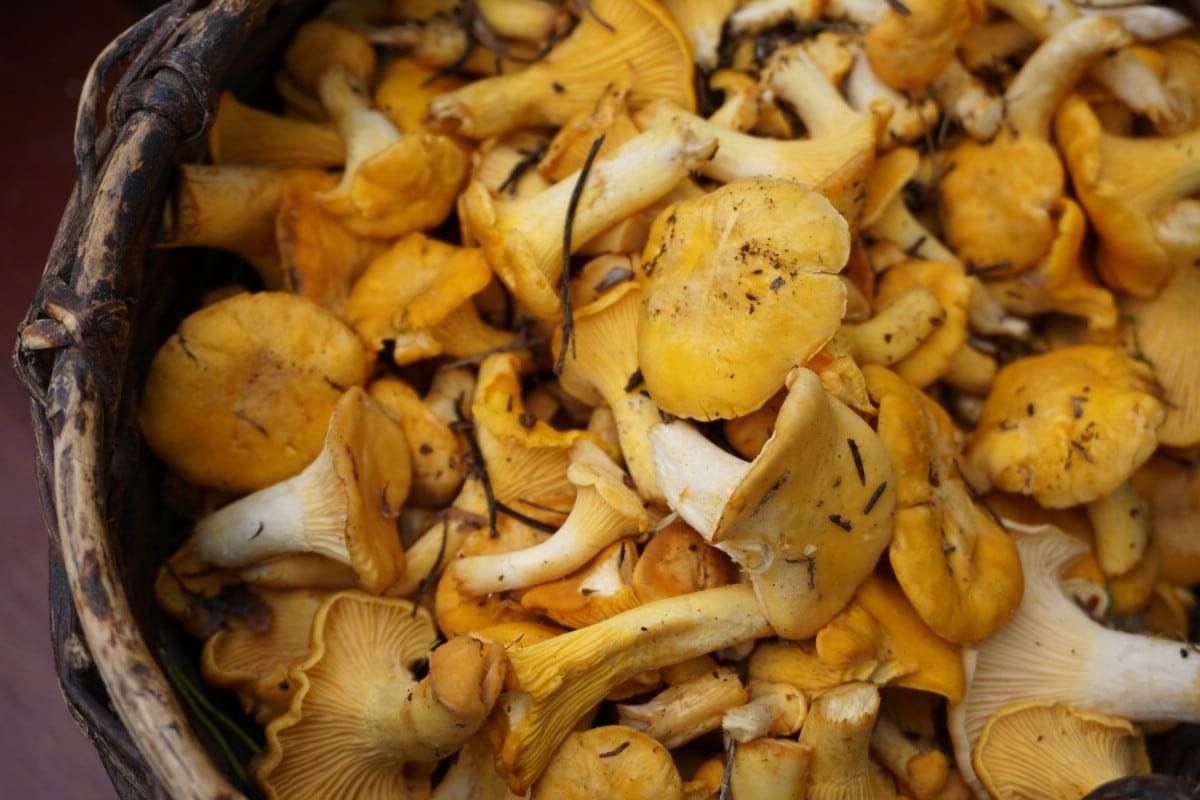
When Is The Best Time To Forage Chanterelles?
Chanterelles are a summer mushroom, usually appearing in mid to late July. They continue fruiting for several months if the conditions are good. It’s impossible to say precisely when they’ll show up each year; so much depends on the temperature, rains, and overall climate.
A lot also depends on where you’re located. Chanterelles in the Southeast are not on the same schedule as those in the Pacific Northwest. In especially dry or drought conditions, they may not make an appearance at all or only come up in small numbers.
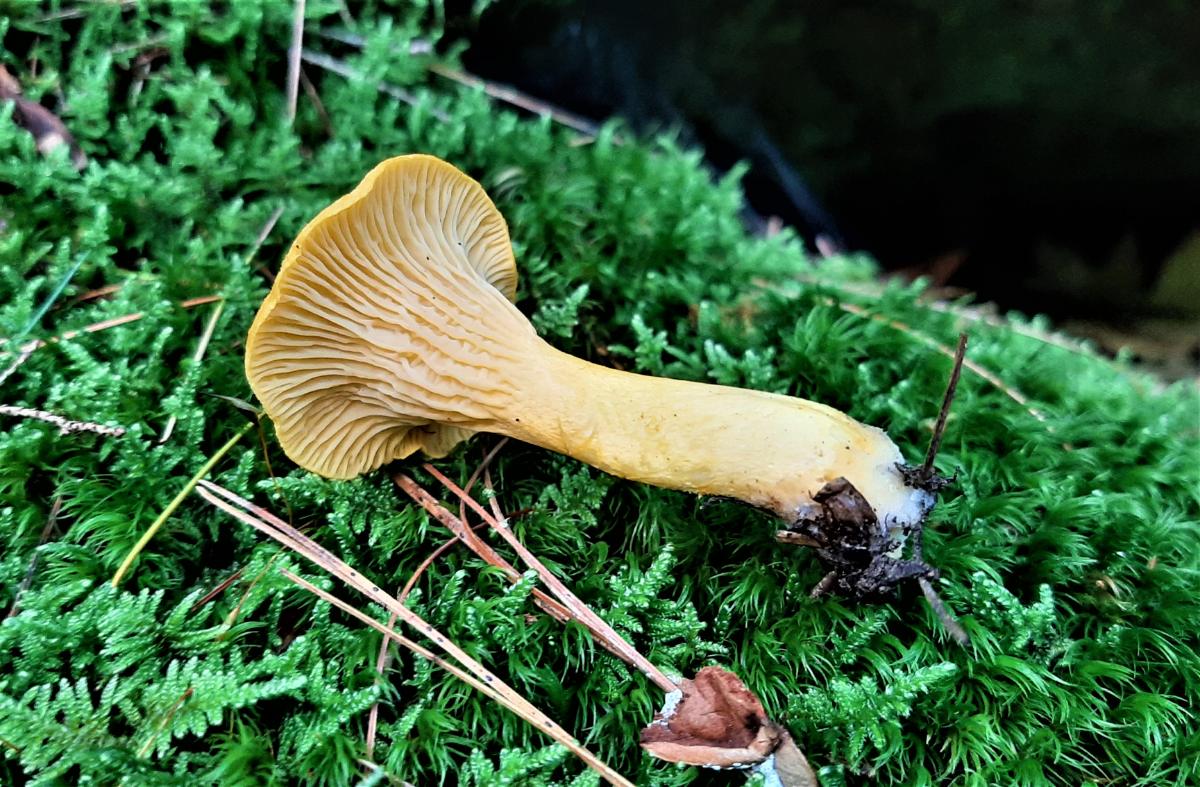
The best way to know when they begin fruiting is to follow some local mushroom foraging groups. The long-time foragers keep a close eye on their known chanterelle patches and let everyone know when the golden gems pop up. Even then, though, it can be tricky.
Sometimes they’ll show up in one area but be two weeks later in a town 30 miles away. This is due to the particularities of microclimates and just the general finickiness of fungi, especially those that grow in association with trees.
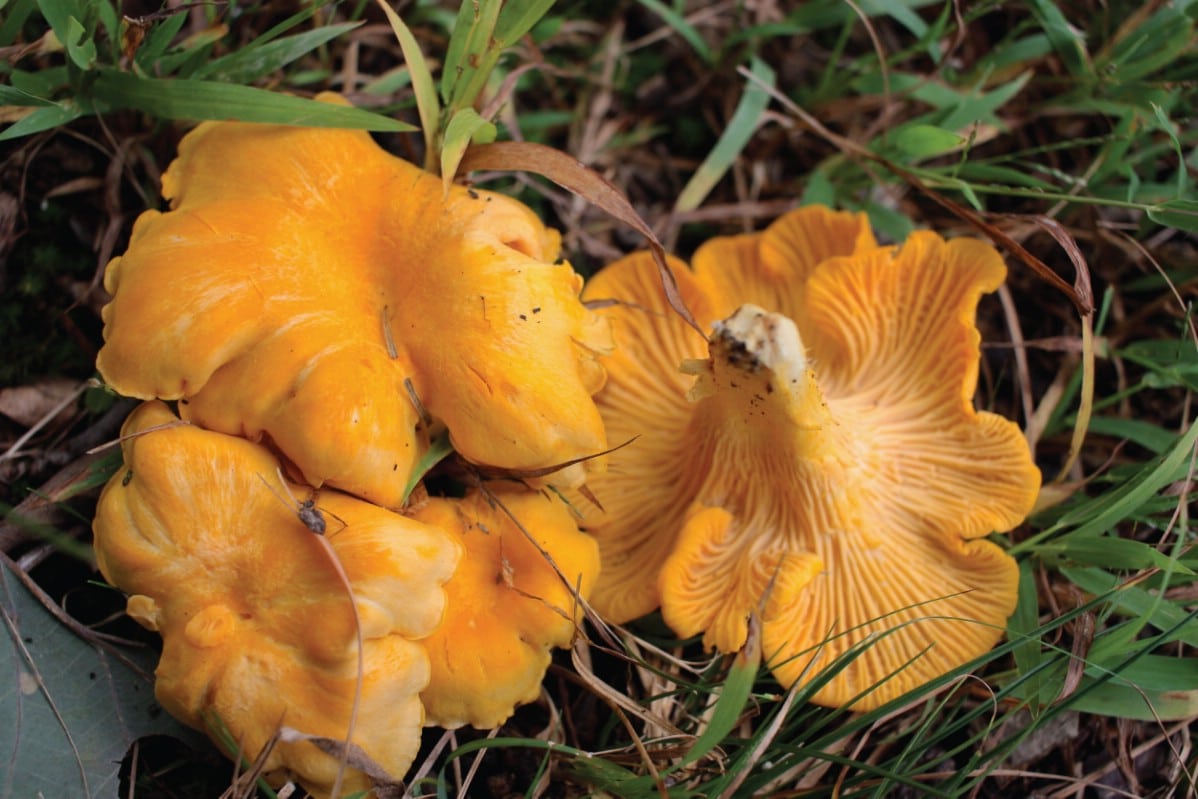
When chanterelles do start popping up, though, they often do so in great numbers, so be on the lookout. The best time to go out looking is mid-summer, 3-4 days after a significant rainfall.
Chanterelles prefer moist ground and wet, humid climate conditions. It takes a few days for them to appear after the rain, which is why it’s best to give them some time to grow first. After they fruit, they’ll grow in spurts throughout the season after good rains.
Look for chanterelles around oaks, conifers, and in mixed forests. That’s a broad spectrum, but each species has its preference. These mushrooms are mycorrhizal, meaning they grow in conjunction with certain trees.
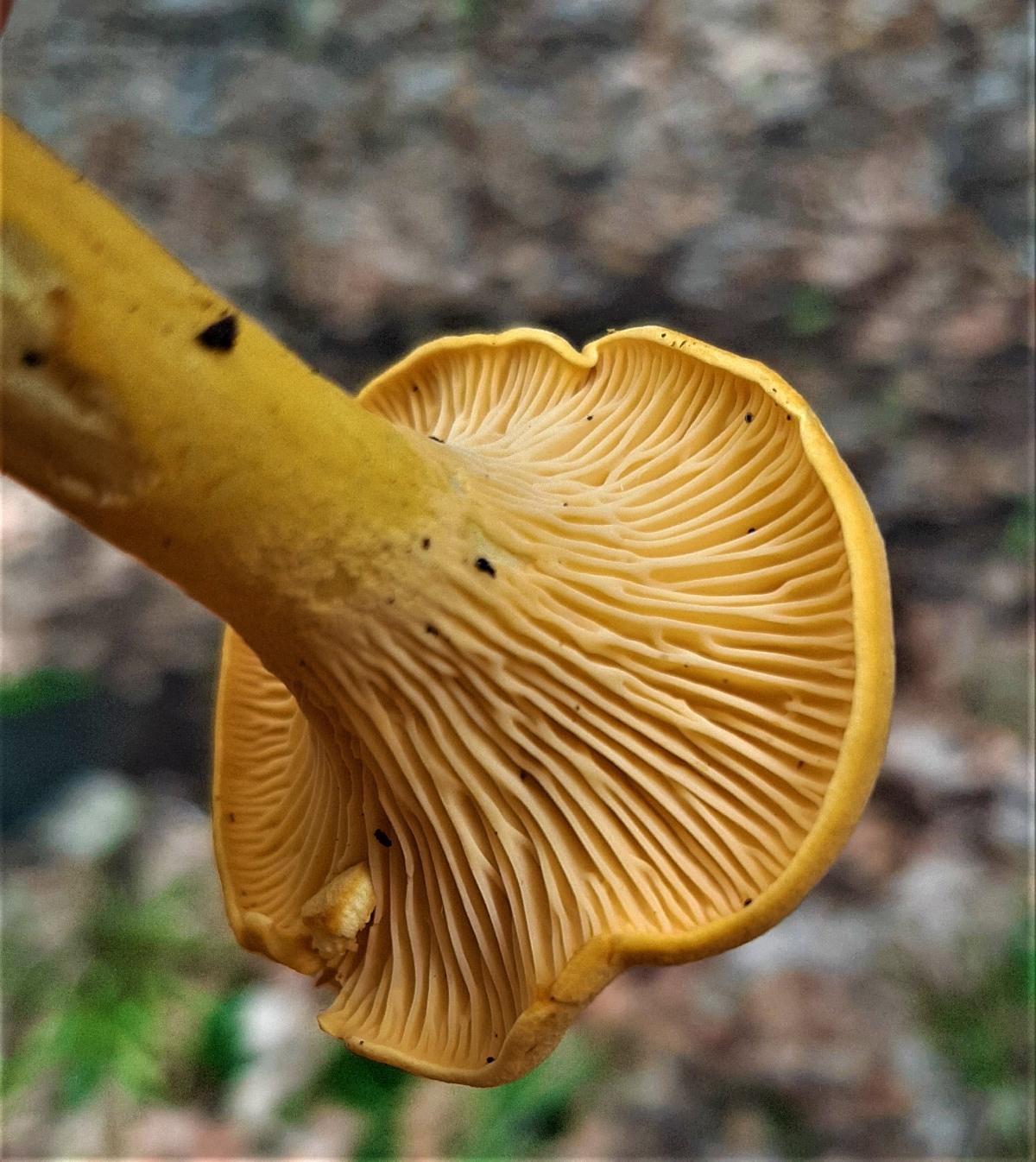
Golden chanterelles prefer conifer forests. The white chanterelle (Cantharellus subalbidus) grows with pines and Douglas fir. California chanterelles (C.californicus) grow specifically with live oaks, while the Appalachian chanterelle (C.appalachiensis) associates with oaks and other hardwood trees. The great thing about chanterelles is that they reappear in the same place year after year. Once you’ve found some, mark that spot!
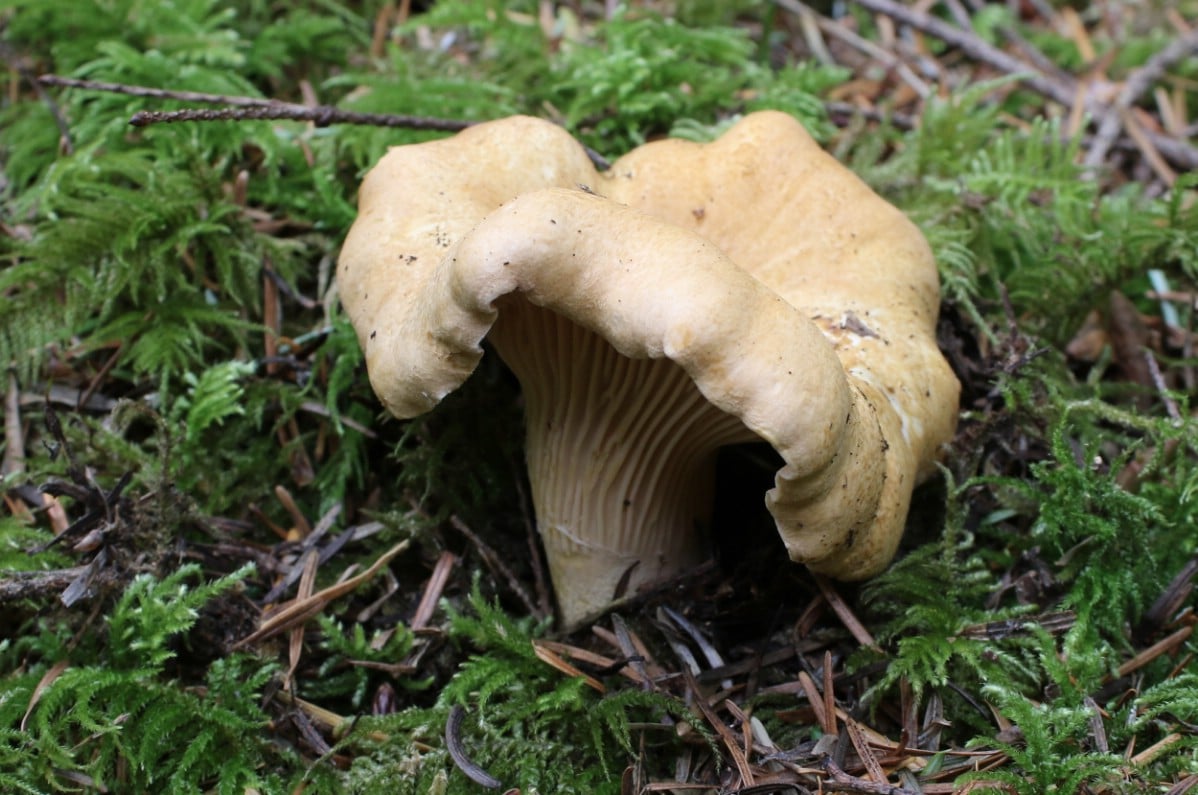
Research the specific types of chanterelles native to your area before hitting the woods. That way, you’ll know whether to be looking under pines, firs, or oaks.
How To Identify A Chanterelle
The are several main identification factors for chanterelles. It’s important to check off all these when identifying these mushroom gems because making a mistake is quite dangerous.
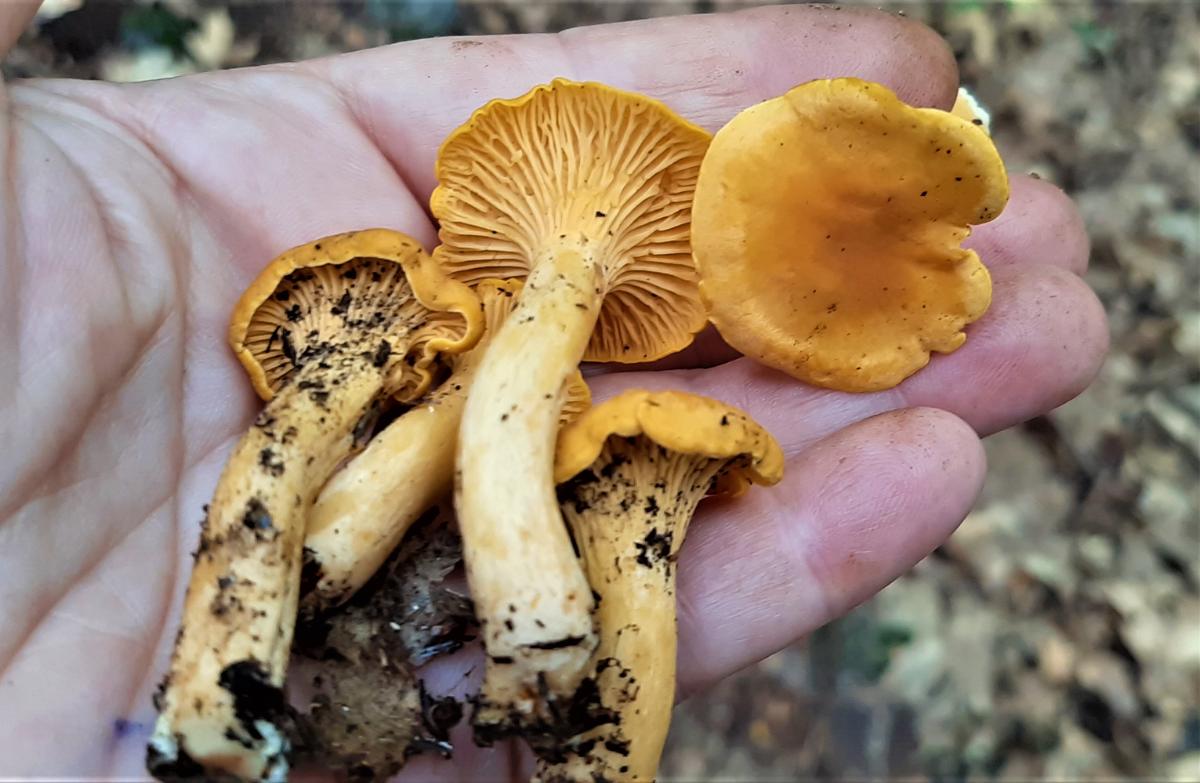
Golden Chanterelle Description
Golden chanterelles range from 2-4 inches tall and 1-4 inches wide. They are light yellow to dark golden yellow-orange. When they are young, chanterelles look like little gold buttons on the forest floor. Some say they look like little egg yolks.
As they mature, they often develop a distinct vase-like or funnel shape with a noticeable indent in the center. This isn’t always the case, though, and some specimens retain a flat or slightly rounded cap. Chanterelle caps are smooth, not pitted, hairy, or wrinkled.
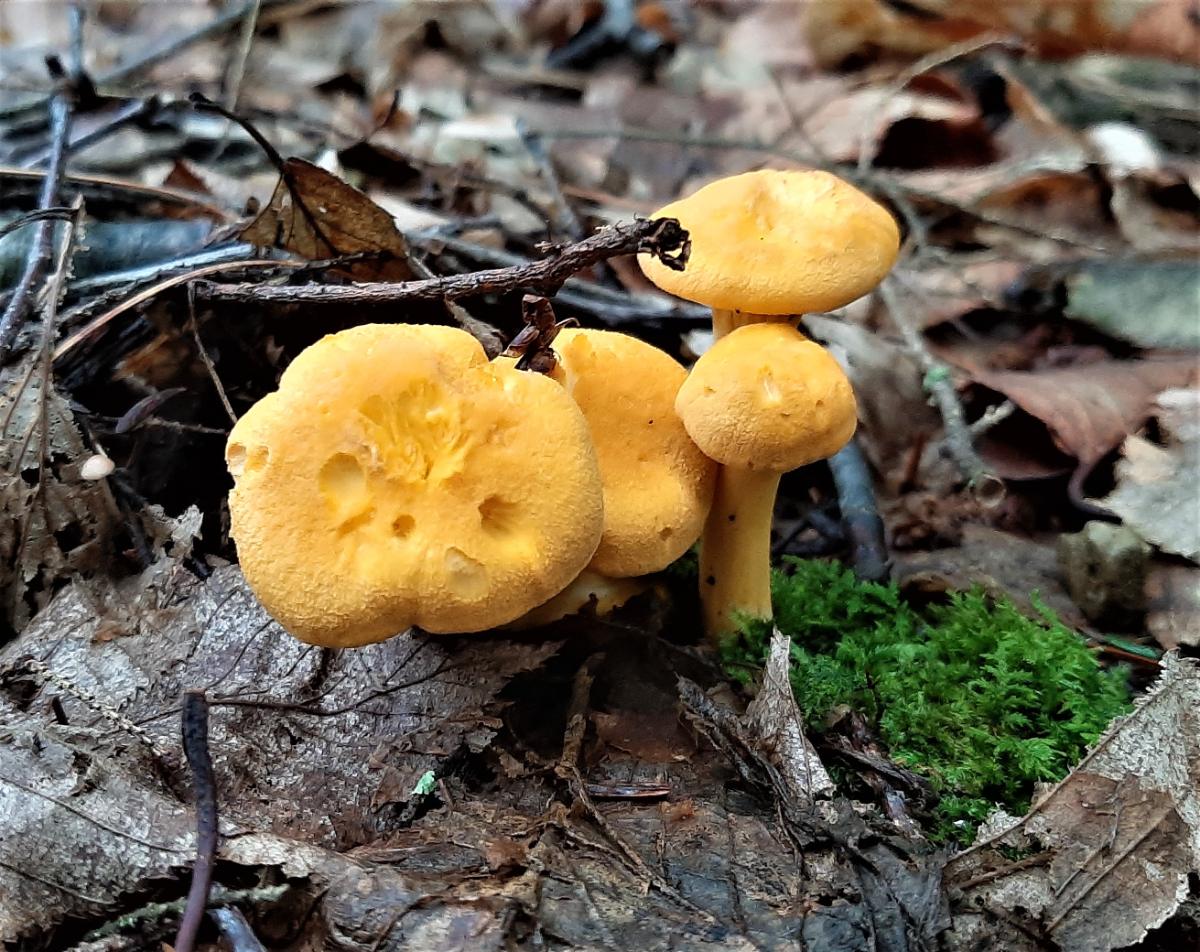
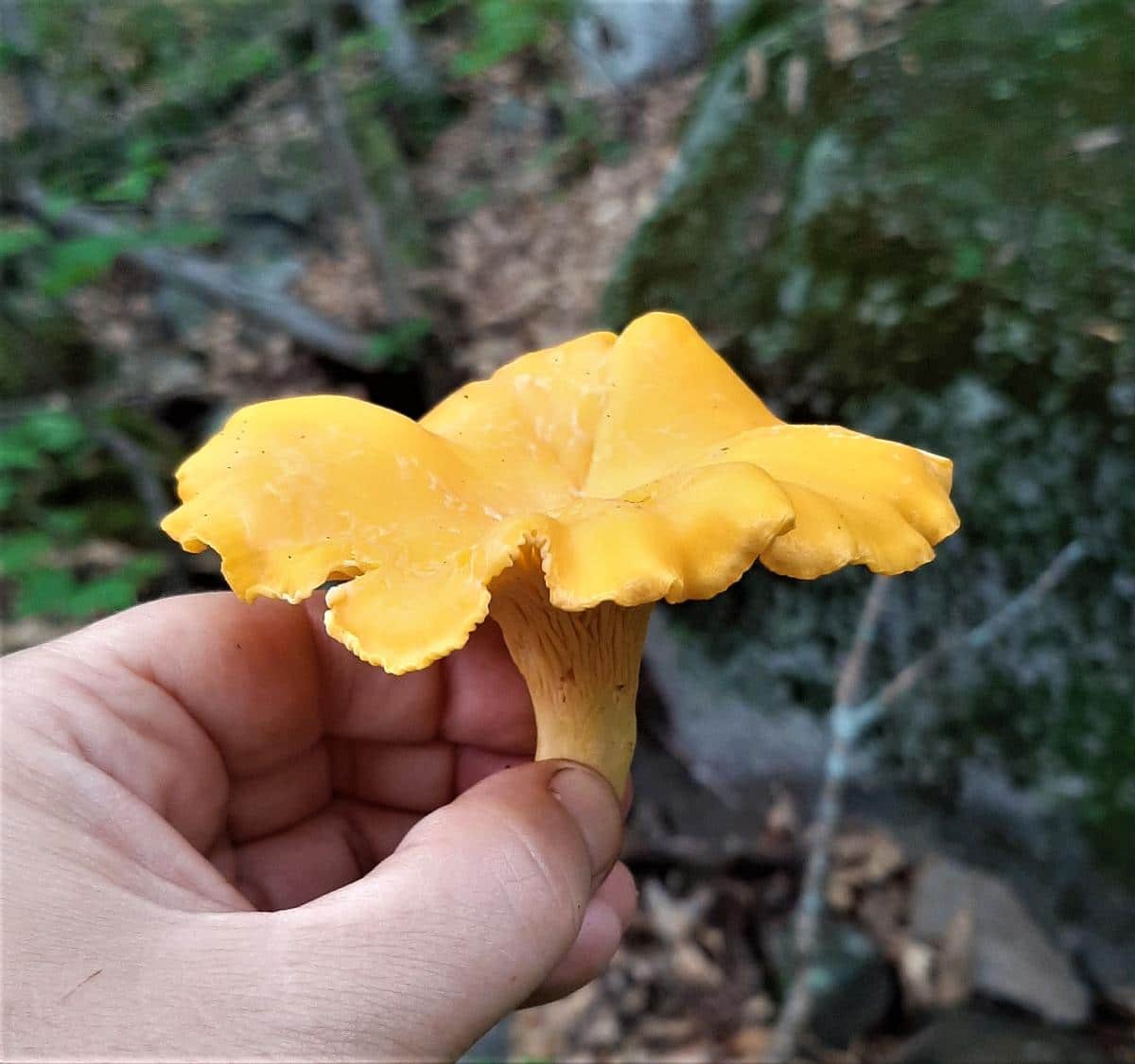
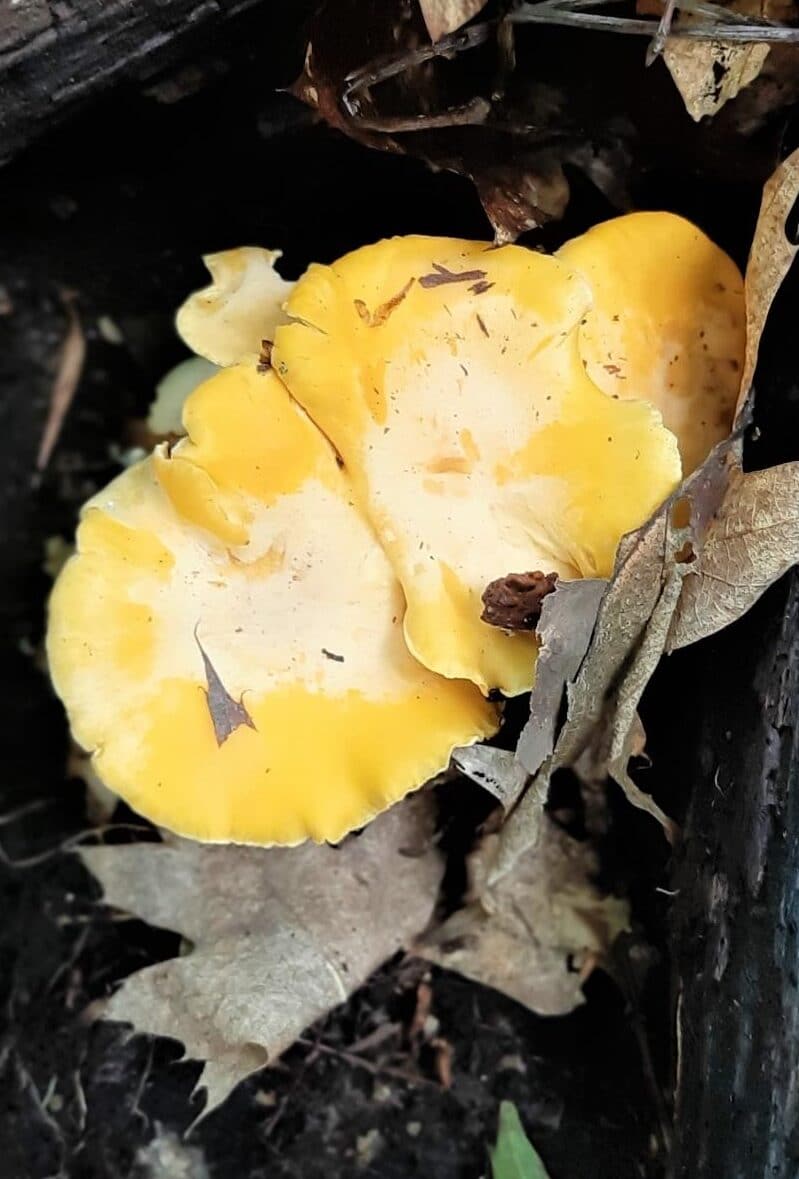
The stem is fleshy, not hollow, and is the same color as the cap. There aren’t any markings or rings around or on the stem. The flesh of these mushrooms is white, or pale yellow, and dense.
Chanterelles smell faintly fruity, like apricots. The fruity smell is quite strong and distinctive if you find a huge patch of them; don’t forget to use your nose when you’re out foraging these wild jewels.
Color
As mentioned previously, most chanterelles are a deep golden yellow-orange color. When you’re out in the woods among brown and green leaves, the bright orange-yellow mushroom is hard to miss. This can’t be the only ID feature, though, because there are a few other mushrooms with similar bright coloring.
The cap, stem, and false gills underneath are generally all the same bright golden color, although this varies within the species. The classic golden chanterelle will be all the same color throughout, though.
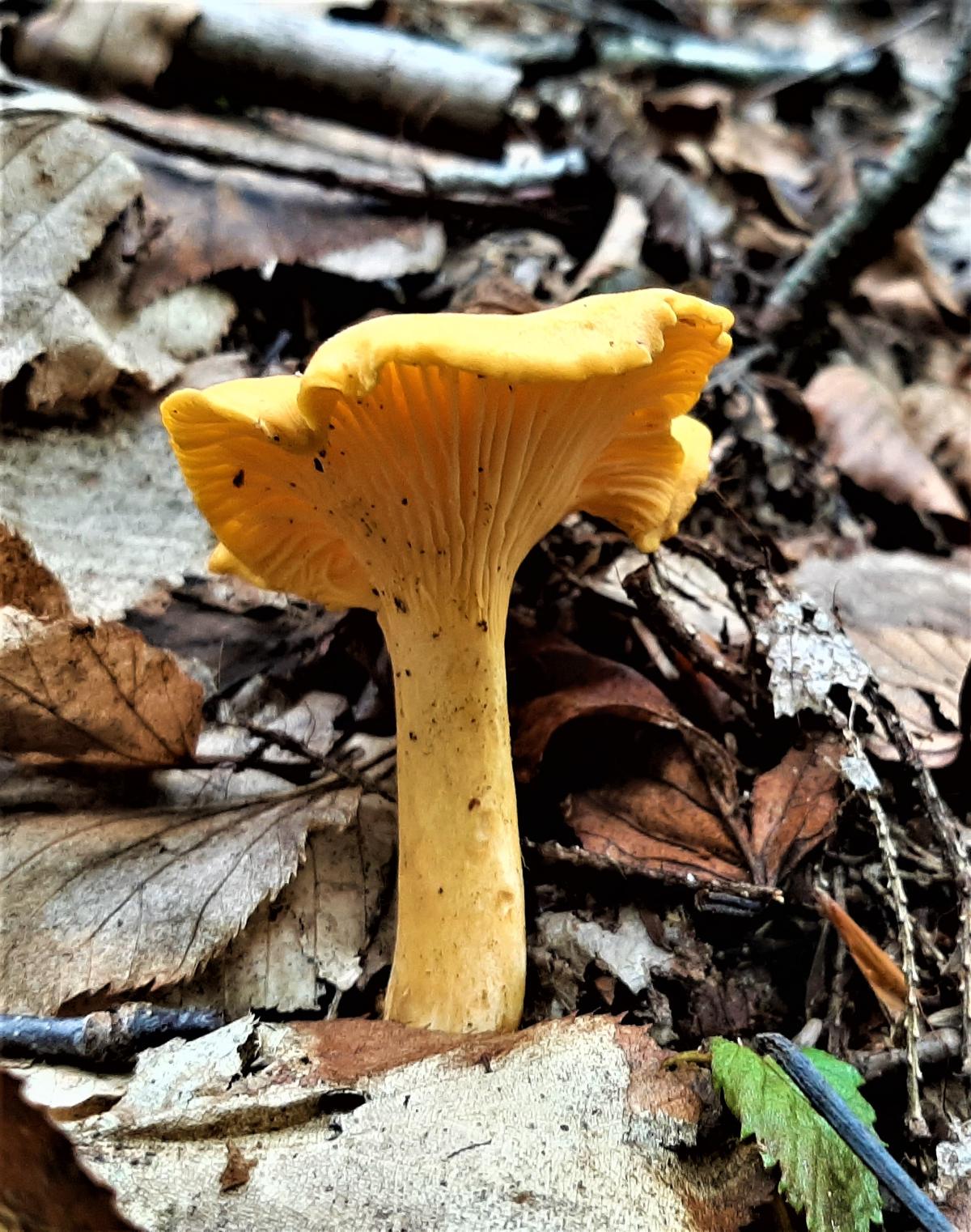
False Gills
Chanterelles do not have true gills like a button mushroom or Shiitake. They do have lines underneath their caps that resemble gills, but you can see they’re different on closer inspection.
False gills are forked ridges or folds, and they do not detach from the stem or cap easily without causing damage to the stem. They look they are melted onto the mushroom; they are not separate or detachable. On chanterelles, the false gills also run down the stem a little ways.
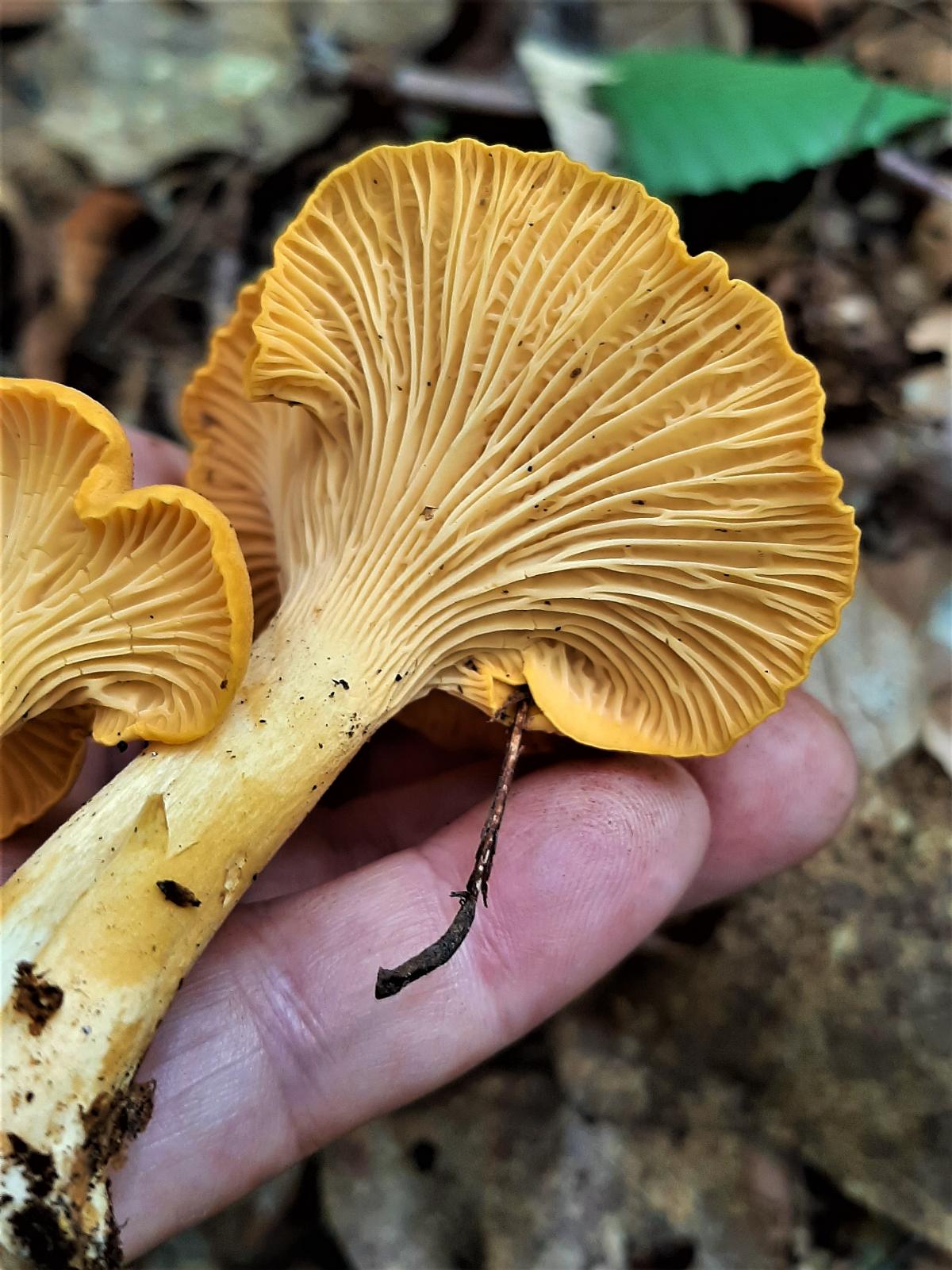
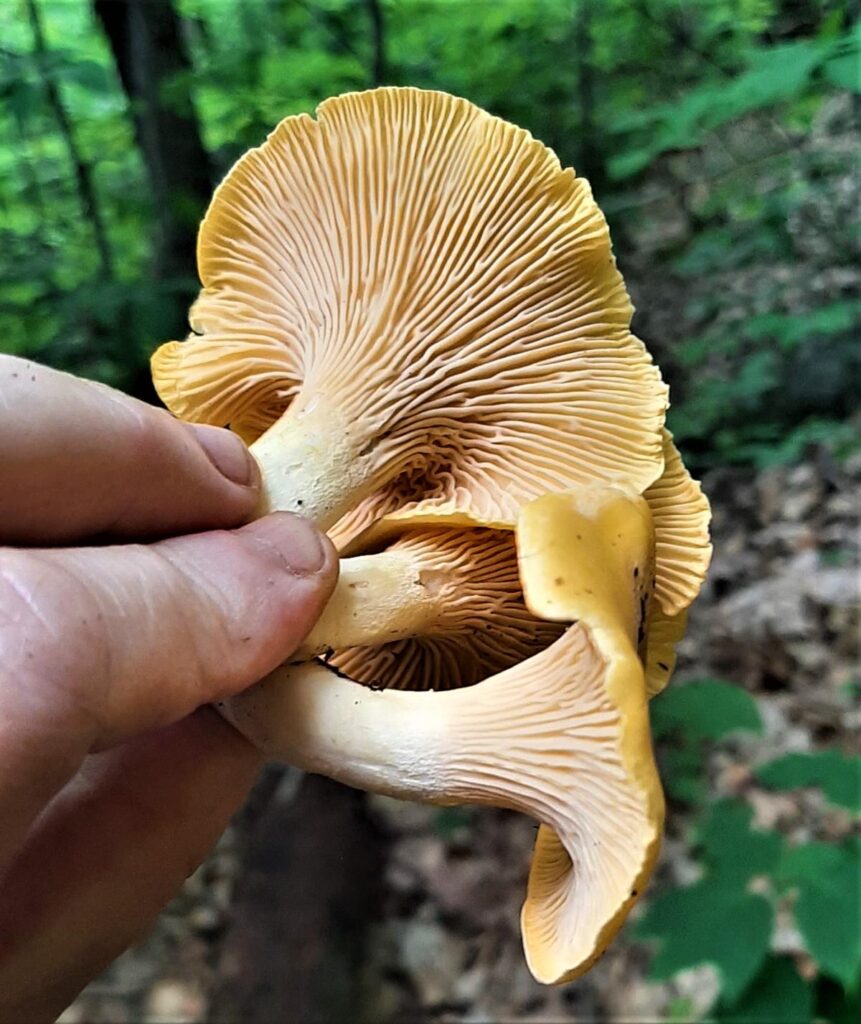
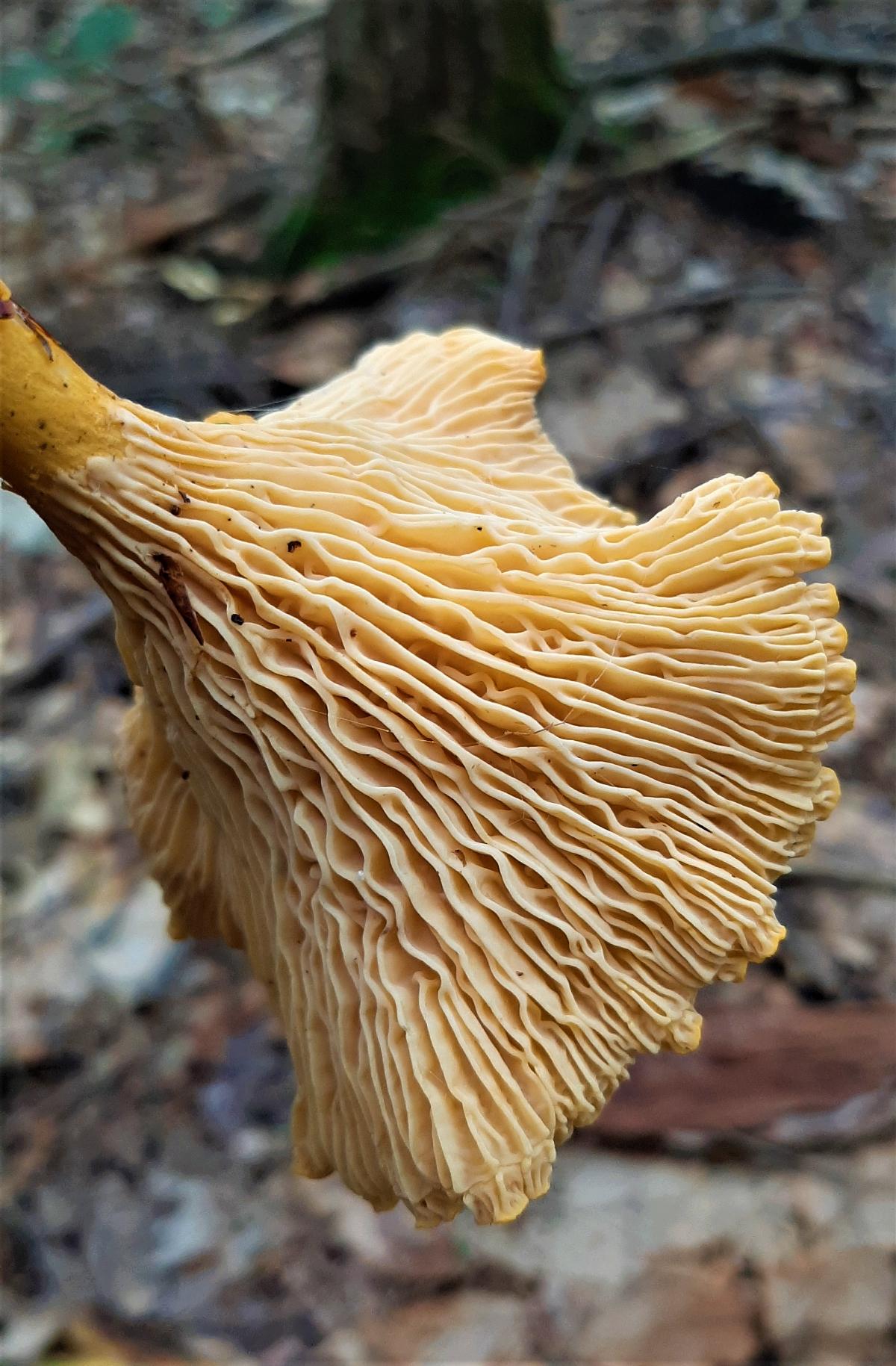
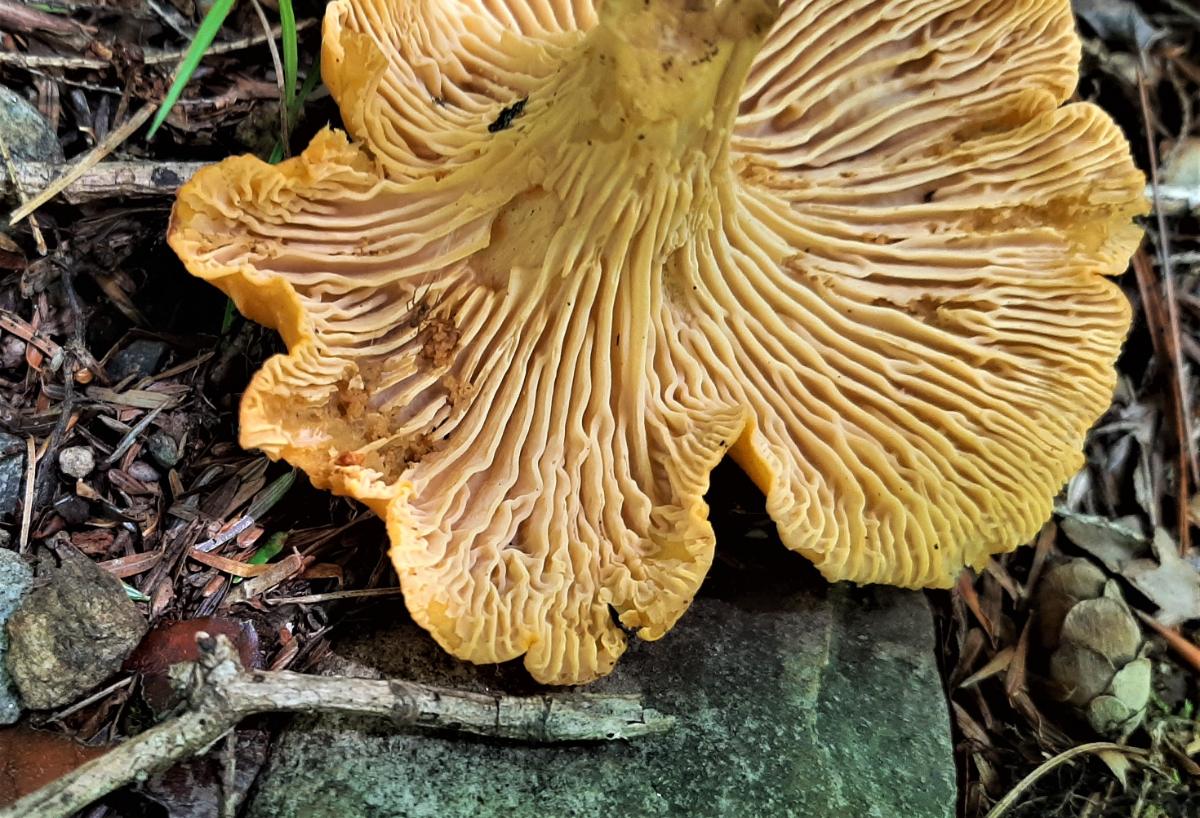
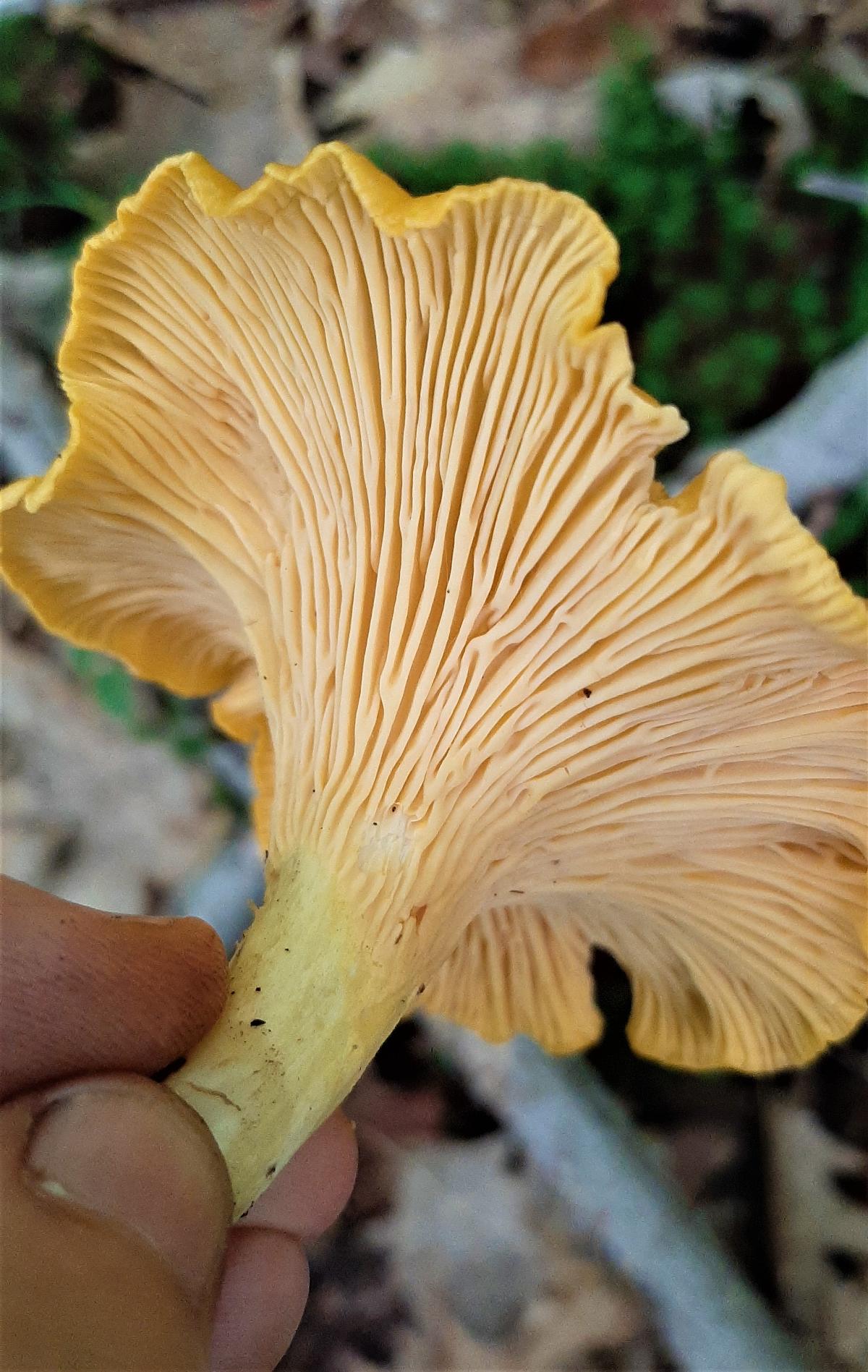
I cannot stress how important it is to understand the difference between true gills and false gills. Study pictures, search the internet, and look at mushroom foraging books until you are comfortable with the difference. This is a critical element in identifying chanterelles; one species of toxic mushroom seems quite similar to the chanterelle except for this difference in gills.
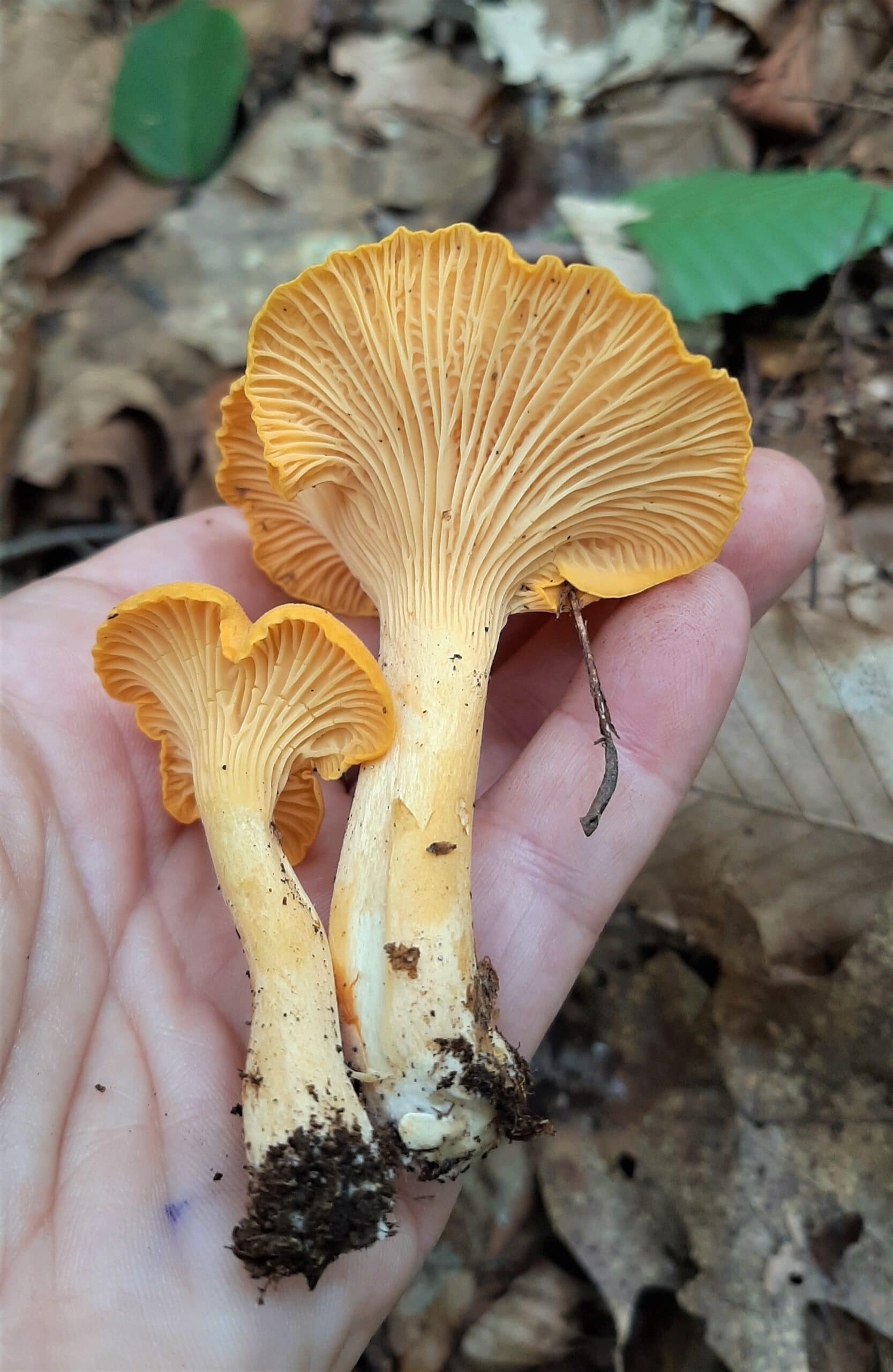
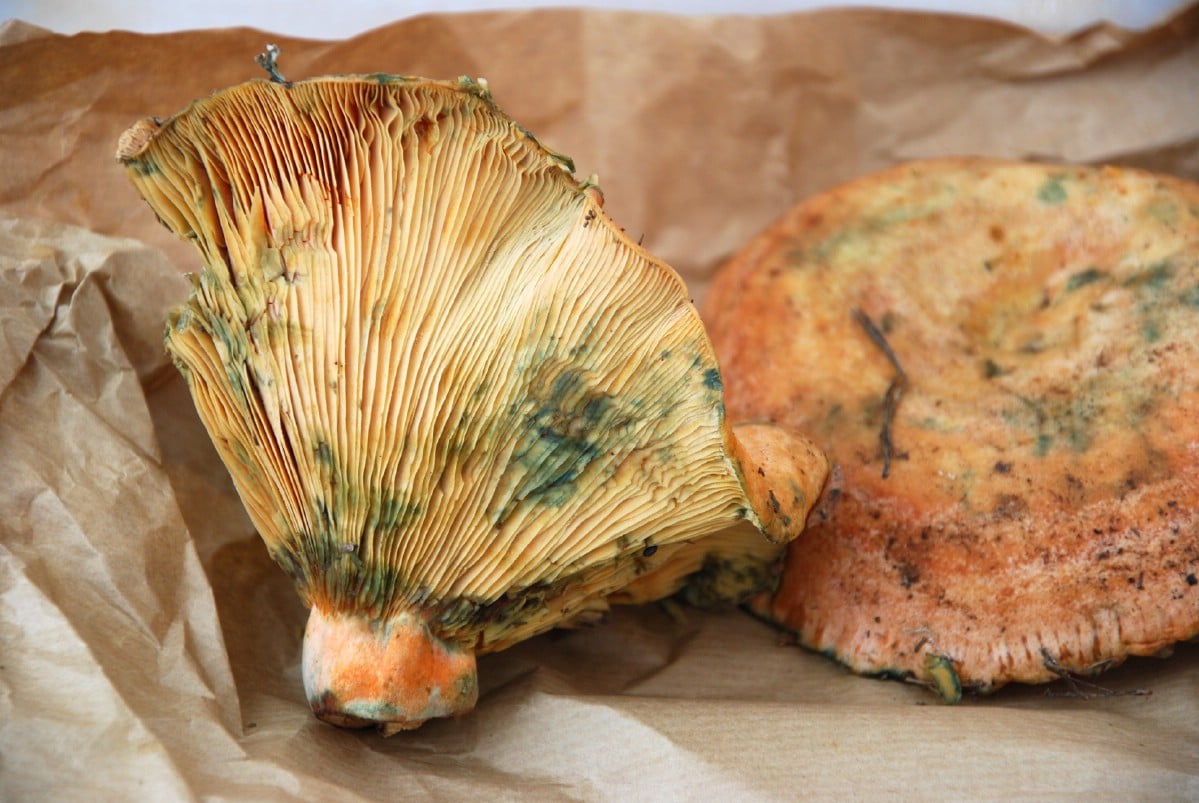
Location
Chanterelles grow from the ground. They never grow on trees, stumps, or any type of wood. The majority of golden chanterelle species grow in conjunction with conifer trees, but others also grow around oaks and hardwoods.
Chanterelles create a symbiotic relationship with host trees and grow in connection with them. This is why it’s crucial to know tree species, as it narrows down the areas to seek out the little golden gems.
They are often found near washes, the edges of dirt roads, or other places where the ground has been disturbed.
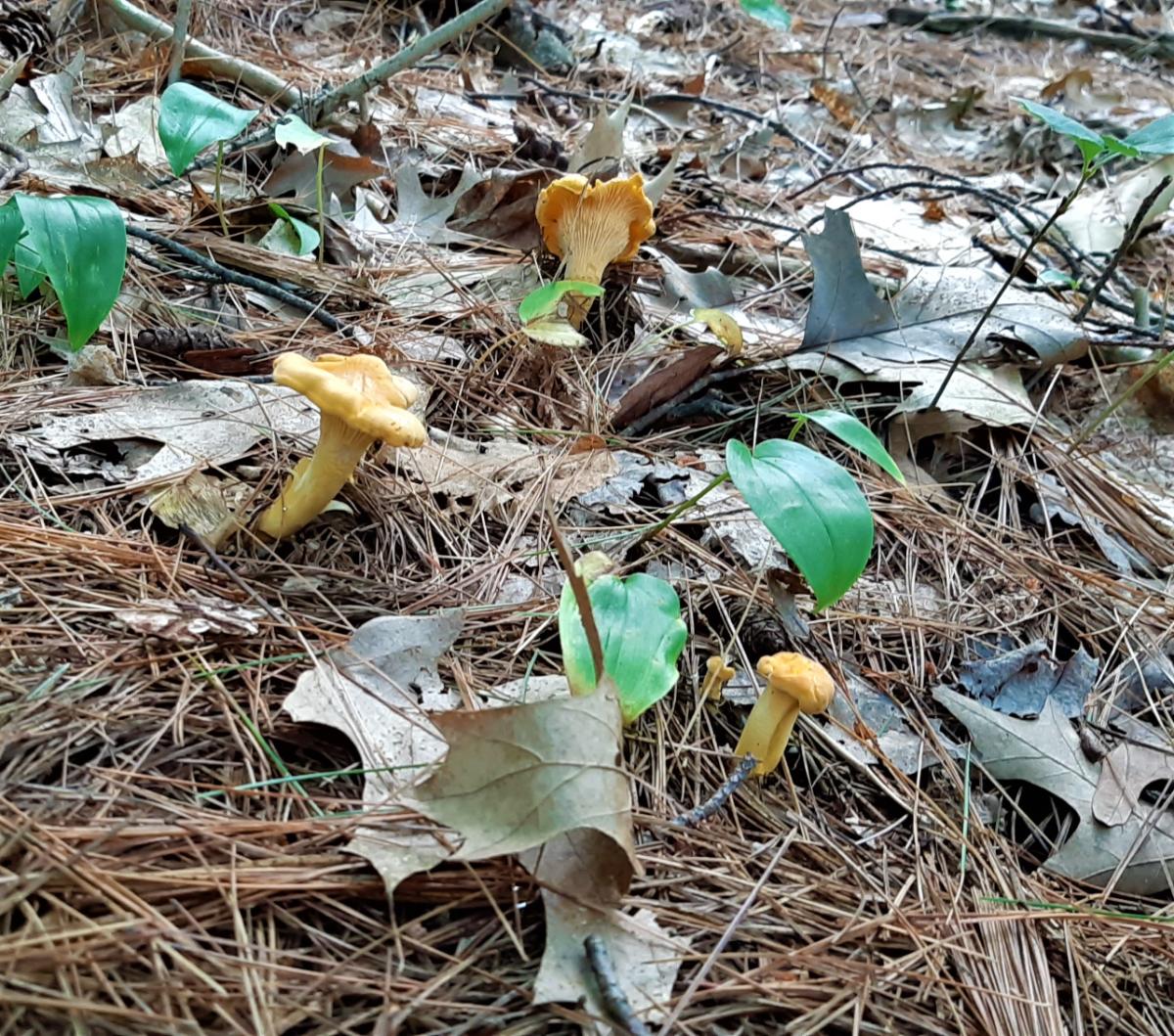
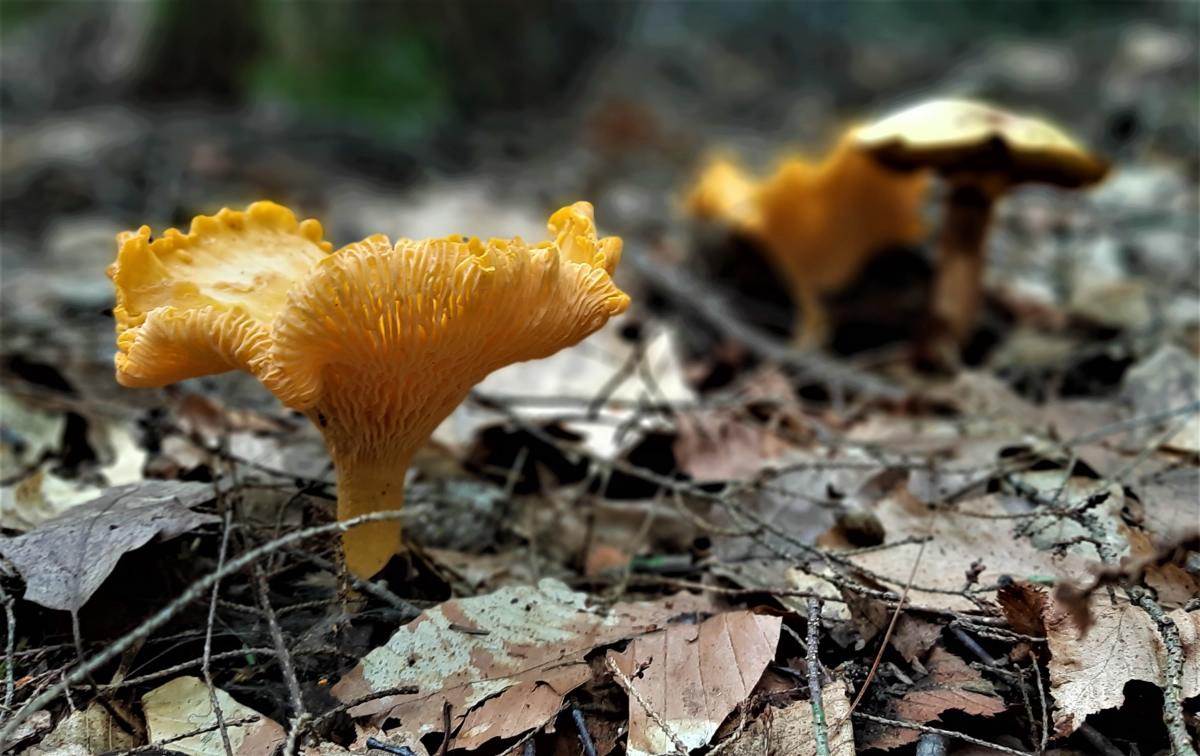
Growth Habit
The chanterelle mushroom grows solitarily in small or large patches. You’ll likely find bunches growing near each other, but each one will be growing on its own. Sometimes, they grow together in small groupings of two or three, but rarely more than that. Chanterelles will never be huge overlapping mushrooms clumps.
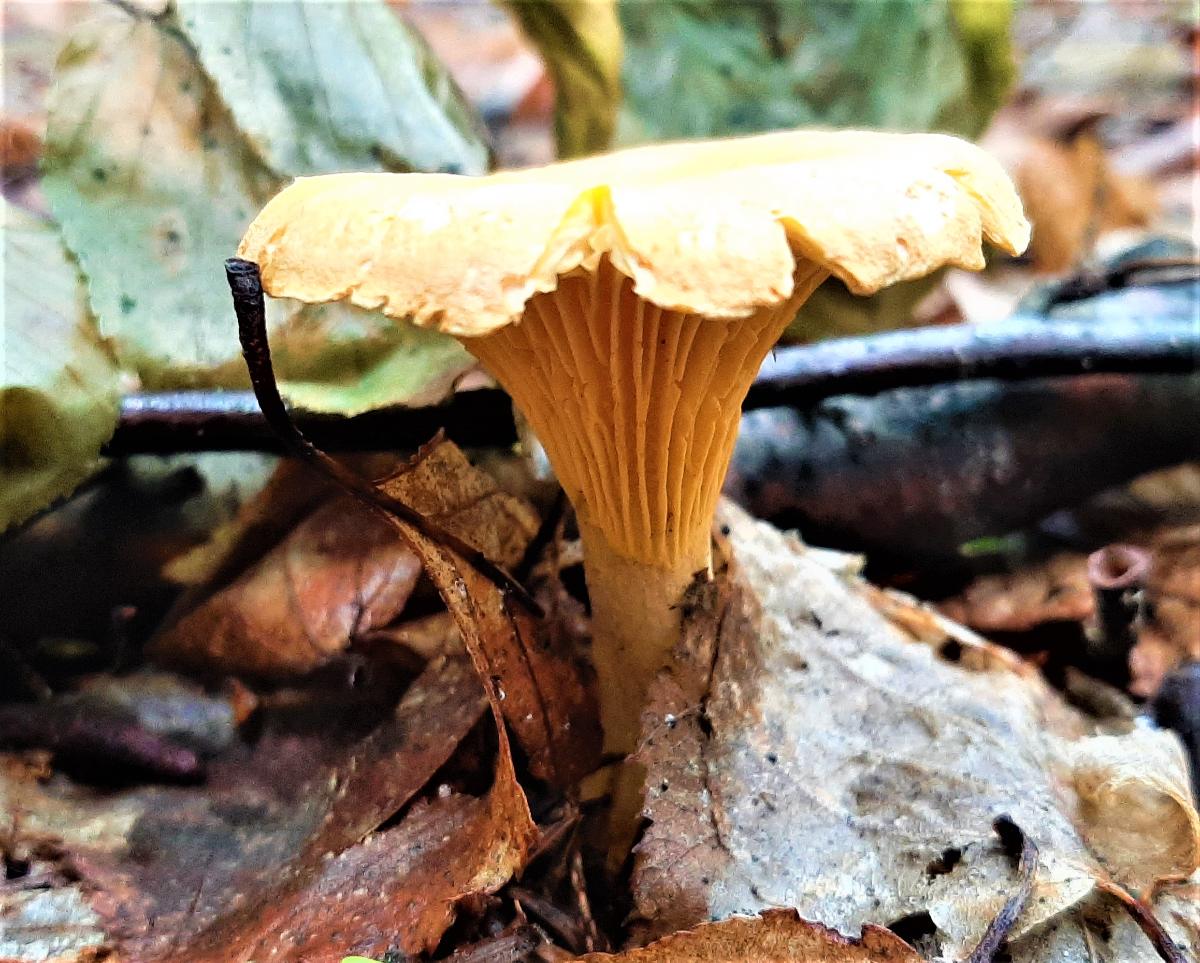
Spore print
White to light yellow
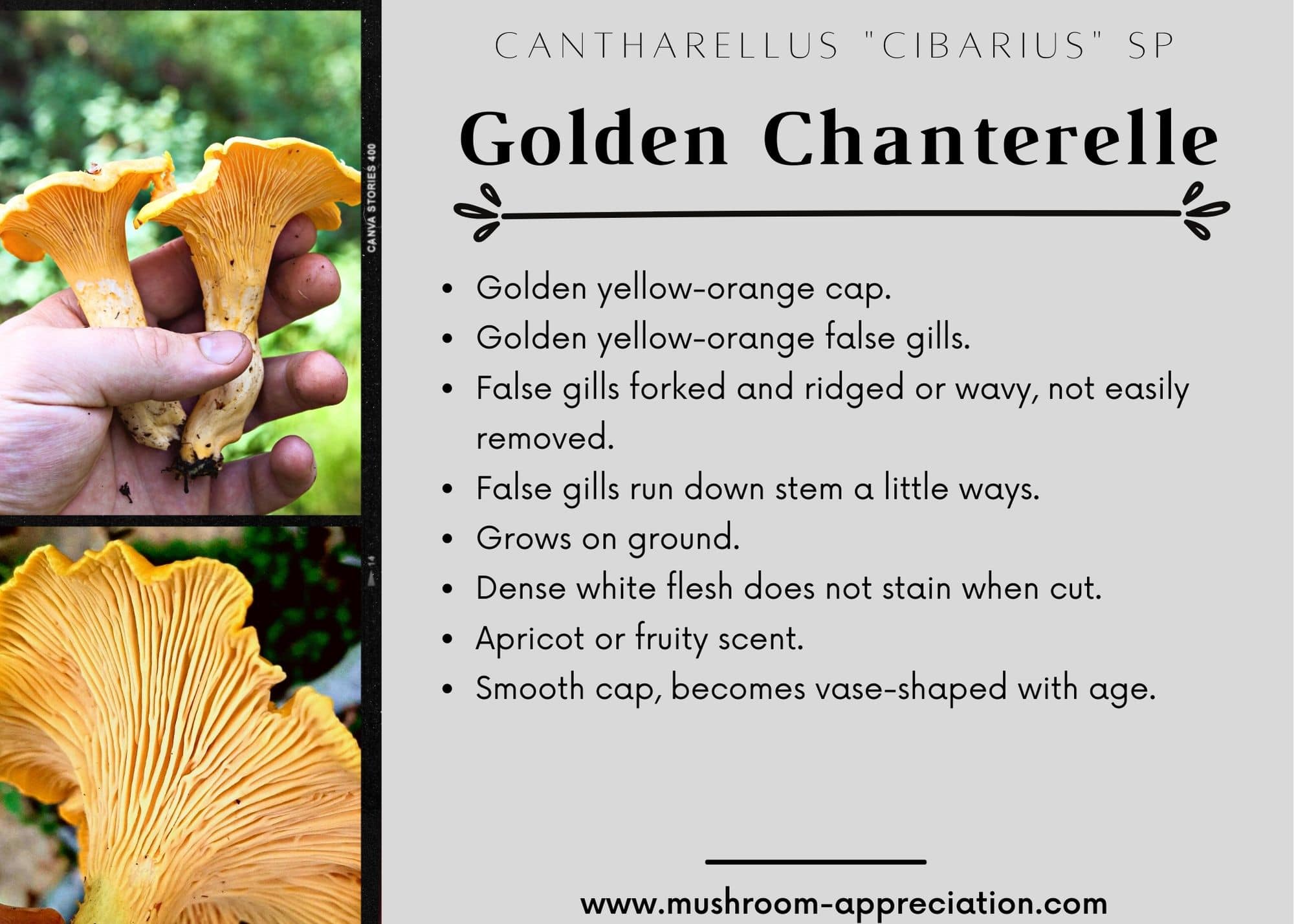
Chanterelle Mushroom Look-Alikes
Chanterelle mushrooms are most commonly confused with either the jack o’lantern or the false chanterelle. Although not fatal, neither should be eaten. These species slightly resemble chanterelles and can be a little confusing for the beginner forager. As mentioned before, if you have a firm grasp on the difference between true gills and false gills, these mistakes won’t be an issue.
Jack O’Lanterns (Omphalotus olearius, Omphalotus illudens, Omphalotus olivascens)
Jack O’Lantern mushrooms contain the toxin muscarine. If eaten, they can cause severe cramps and diarrhea.
One of the best ways to identify a chanterelle from a jack o’lantern is by examining the gills. Remember that chanterelles have false gills, which are forking wrinkles on the underside of the mushroom that appear “melted”. Jack o’lanterns have true gills, meaning they are non-forked and knife-like.
Other ways to tell a jack o’lantern from a chanterelle:
- Jack o’lanterns grow in large overlapping groups with the stems attached. Chanterelles are usually solitary or in a small bunch.
- Jack o’lanterns are more orange-brown, less yellow.
- Chanterelles will always be near trees as they are mycorrhizal fungi, but do not ever grow on trees. Jack o’lanterns grow from rotting wood. Usually they’ll be attached to a tree or stump. Sometimes, the wood is buried so you can’t see it.
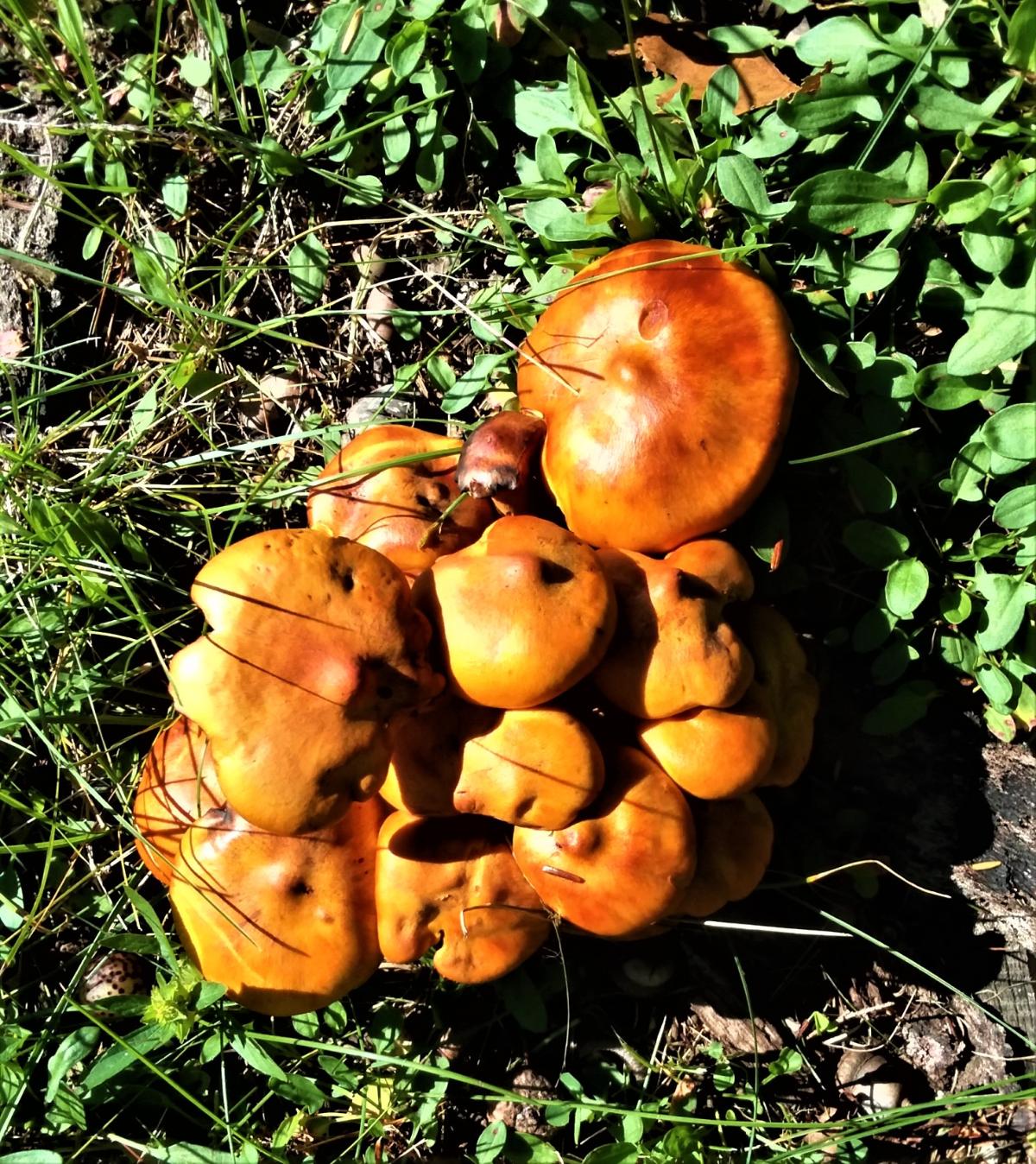
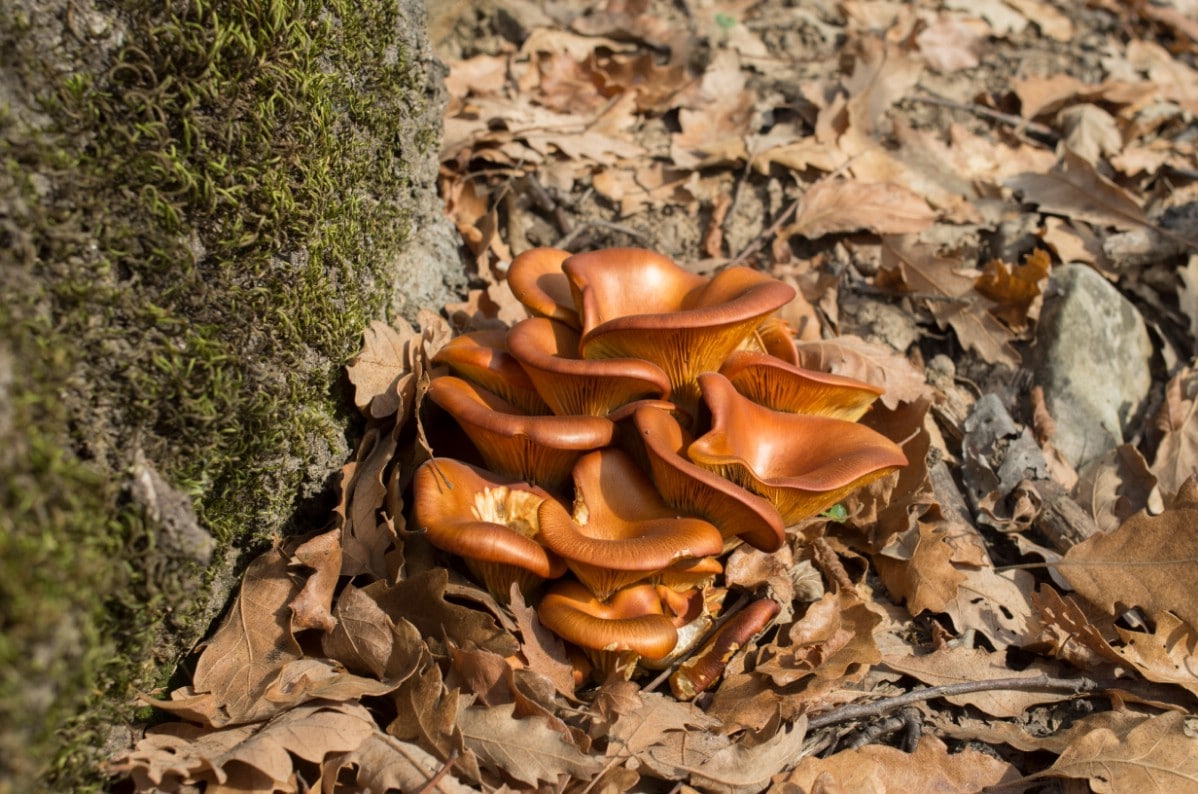
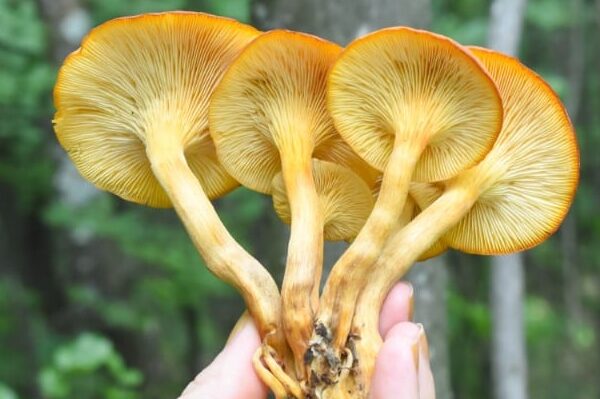
An experienced eye usually won’t have a hard time distinguishing between a jack o’lantern and a chanterelle. Take some time to look at pictures and try to find examples in the wild. A trip out with your local mushroom club can be a great help.
False Chanterelle (Hygrophoropsis aurantiaca)
The next look-alike is the aptly named . Although some say this mushroom is edible, it reportedly is far too bitter to taste good. There are claims that this mushroom is outright poisonous, giving them upset stomachs and digestive problems. Thus it’s best to avoid the false chanterelle altogether.
Again, the main way to tell a true chanterelle from false is by examining the gills. False chanterelles have true gills, although they are forked on the edges. They still appear as close blades rather than lumpy folds.

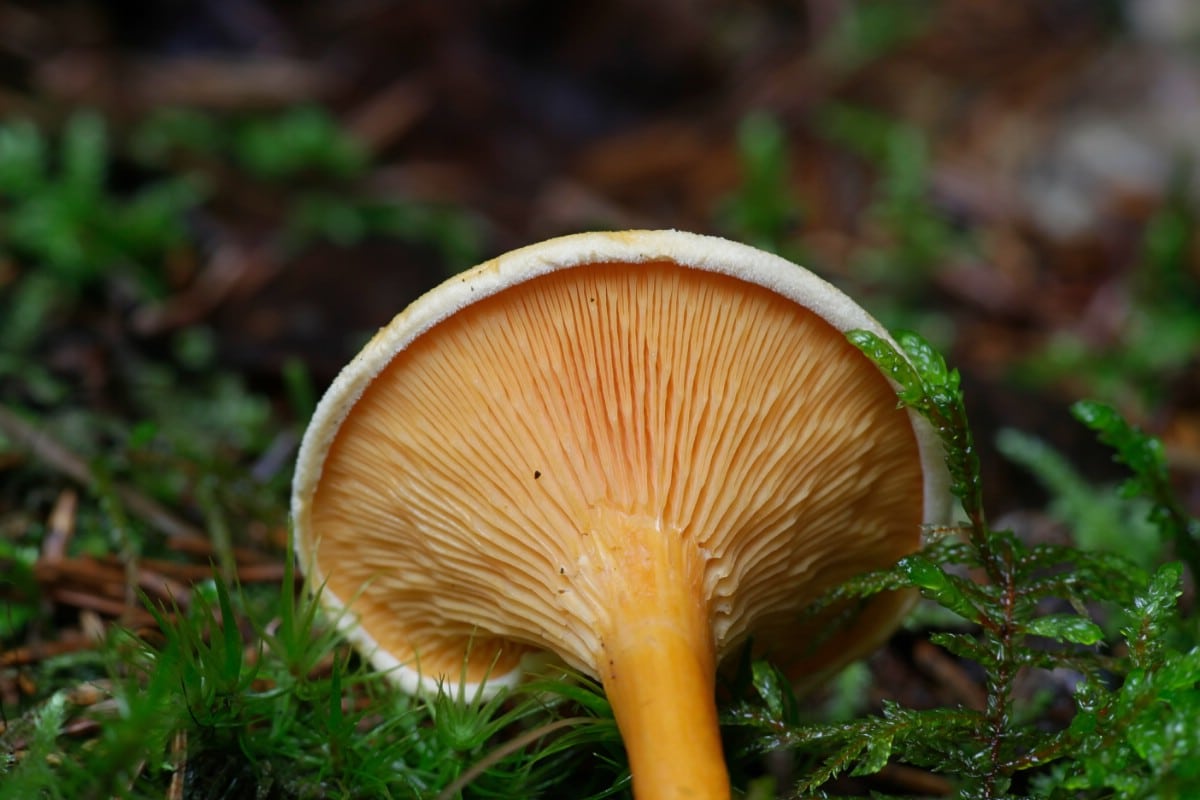
Another way to distinguish the two is with color. The false chanterelle is a deeper orange with no yellow. The color is also graded, meaning they’re darker at the center of the cap rather than one uniform color. False chanterelle caps are usually a bit fuzzy, too, while true chanterelle caps are smooth.
Yellow Amanita (Amanita flavoconia)
This eastern North American amanita slightly resembles a chanterelle. Both have bright yellow-orange caps, but they vary significantly otherwise. The yellow amanita usually has white or yellowish scales on the cap. It also has true gills that are white and a long stem. Yellow amanita has a partial veil that becomes a skirt around the stem and bulbous base, two other features the chanterelle doesn’t share.
This is not a mushroom you want to confuse with chanterelles. Amanita species are the most common cause of fatal mushroom poisonings. Fortunately, on close inspection, this amanita is obviously not a chanterelle.
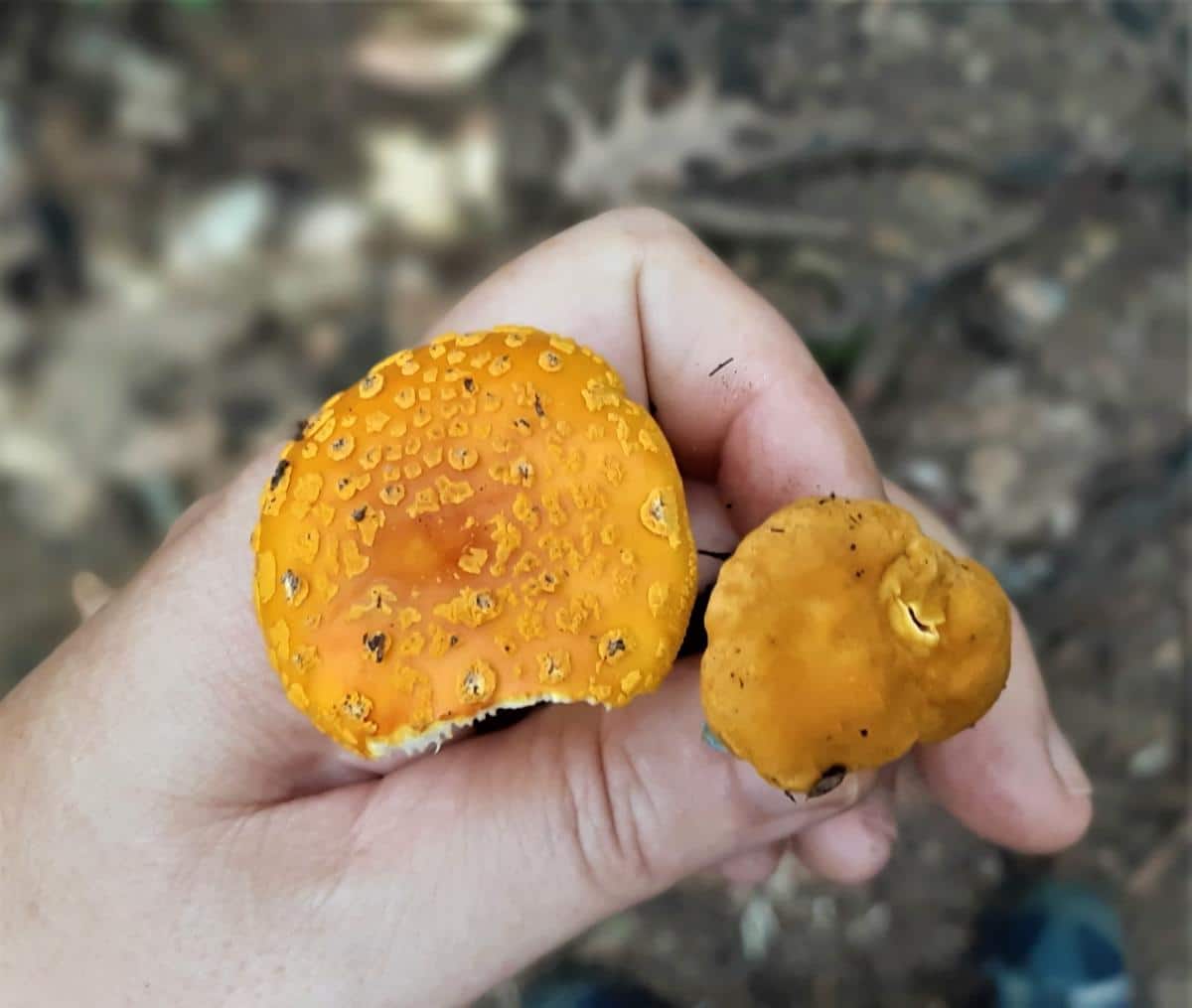
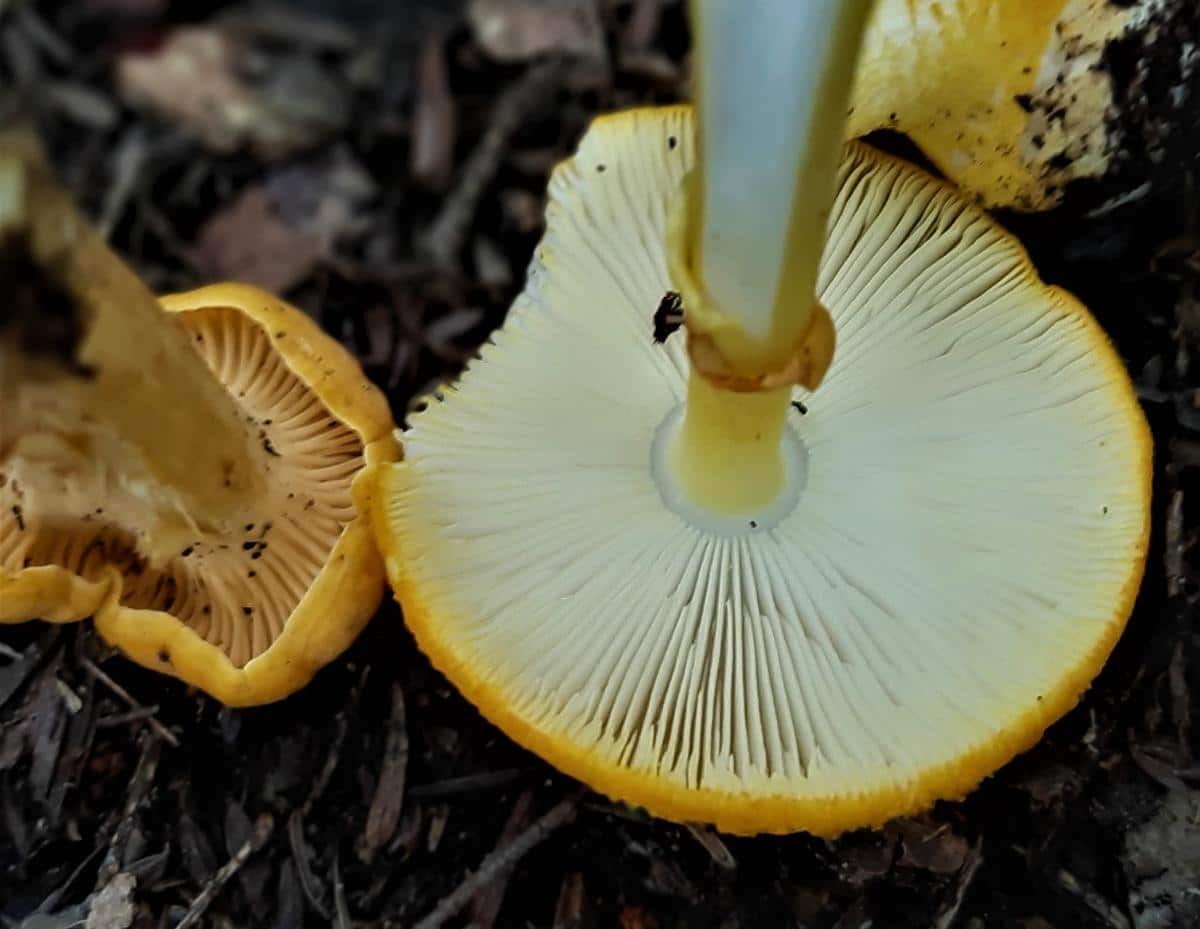
Scaly Vase or Woolly Chanterelle (Turbinellus floccosus)
There’s a good reason this mushroom is called the woolly chanterelle. It grows in a vase or trumpet shape and has false gills, like the chanterelle, that look like ridges or wrinkles. Scaly vase mushrooms are orange, like chanterelles, too. However, chanterelles are usually more golden yellow than orange, while scaly vases are orange to pinkish.
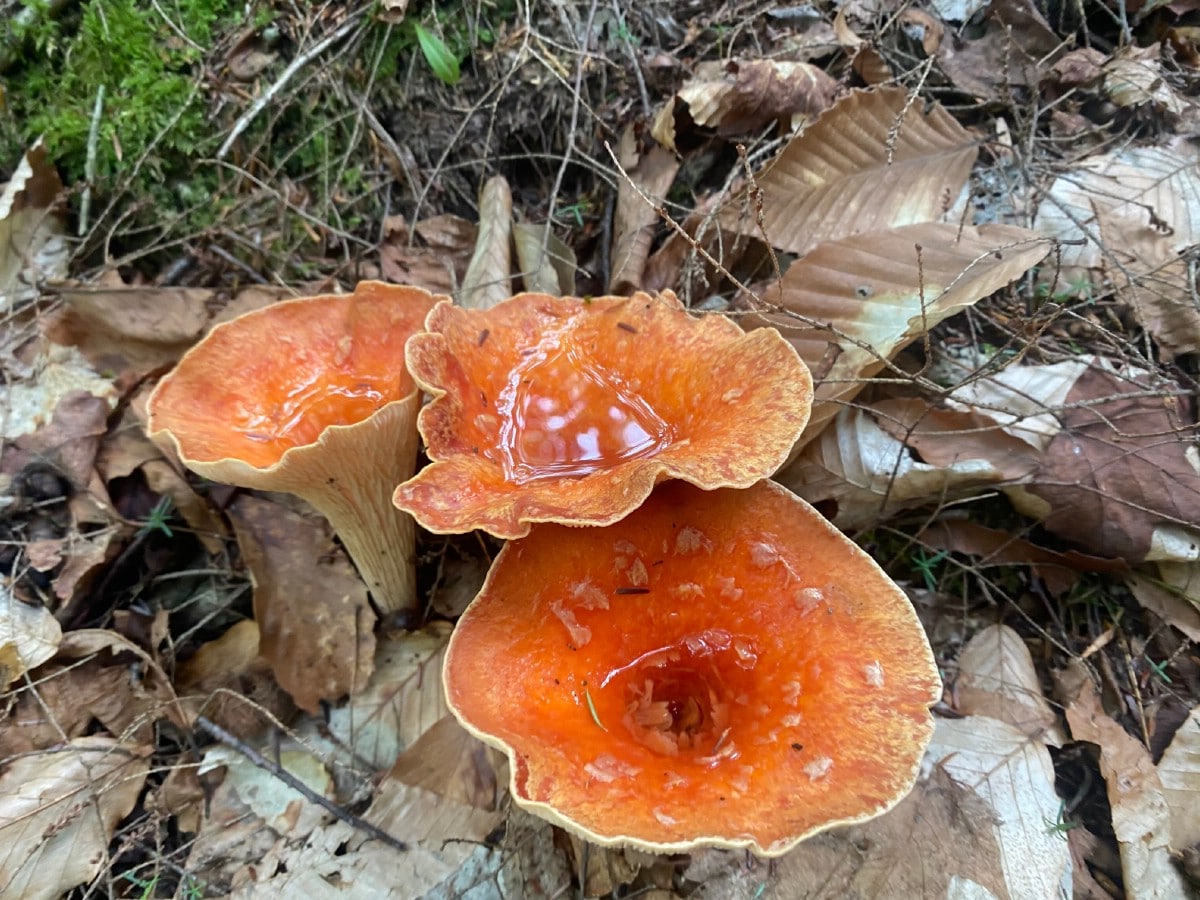
Scaly vase grows with conifers in late summer and autumn, the same fruiting season as chanterelles. The main difference is that the scaly vase is always cone or vase-shaped – it does not develop a cap like a chanterelle. Also, the false gills extend down the entire stem, top to bottom.
The overall shape of the scaly vase is significantly different from a young chanterelle. Older chanterelles develop a vase-like shape, which is where the confusion usually happens.
Check out the Scaly Vase mushroom identification guide to learn more about this neat mushroom.
In some regions of the world, this mushroom is considered edible. However, for many, it causes gastrointestinal distress. Proceed with caution on this one!
Cooking With Chanterelles
Once you’ve found these golden nuggets, the really fun part begins – eating! Chanterelles are such a treat for the table; they should be treated with care and respect. The fruity apricot scent remains during cooking, but it is very light and delicate.
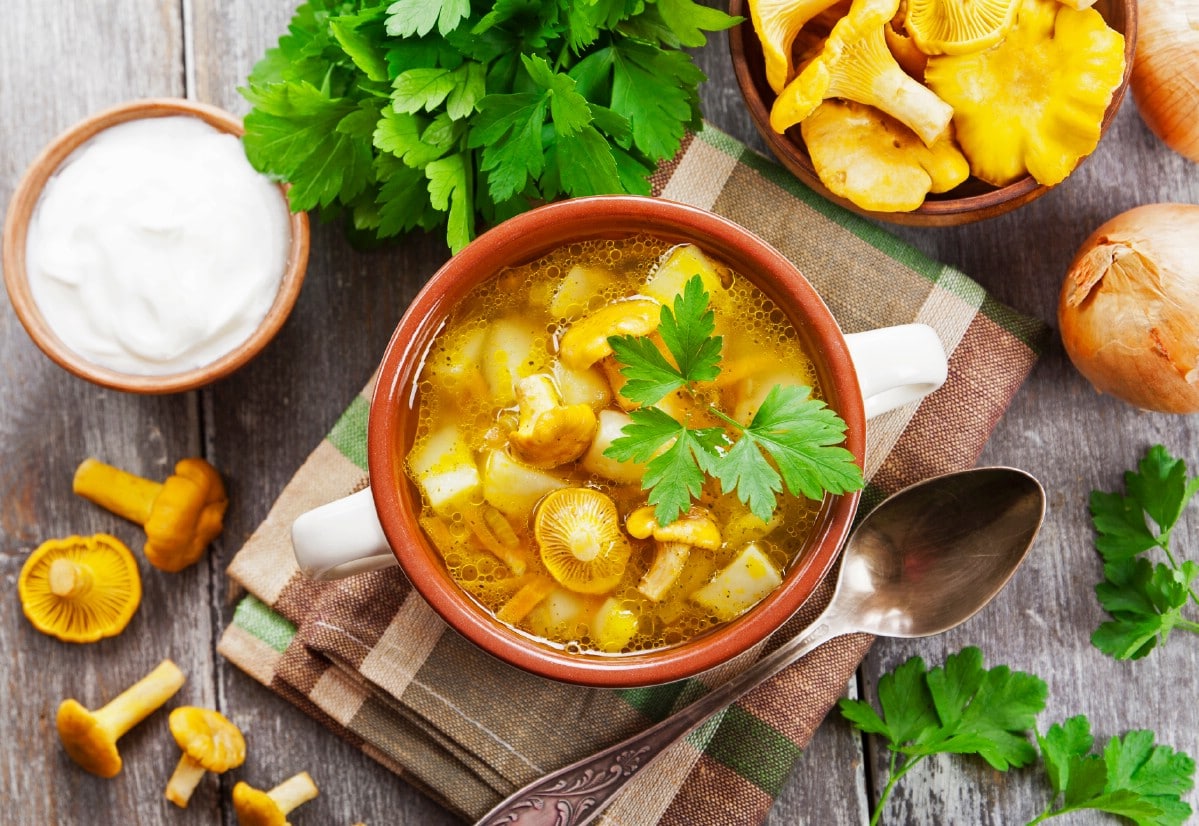
One of the best ways to prepare chanterelles is to do so simply. A light sauté with olive oil and salt is often all they need. Don’t prepare them in a heavy sauce or in a way that their delicate flavor will be overwhelmed.
Chanterelles contain a lot of water, which is best cooked off before adding seasoning. We always dry saute them first to release the moisture, then add the oil, garlic, or spices. This prevents a soggy mushroom dish!
Amazing Chanterelle Recipes
Storing & Preserving Chanterelles
Fresh chanterelles are best stored in a paper bag or newspaper in the refrigerator. Never store them in plastic as this causes moisture to accumulate, and they will decay quickly. Kept in a paper bag, chanterelles will remain fresh for up to 5 days. It’s better if they are used as soon as possible, though, for the best quality.
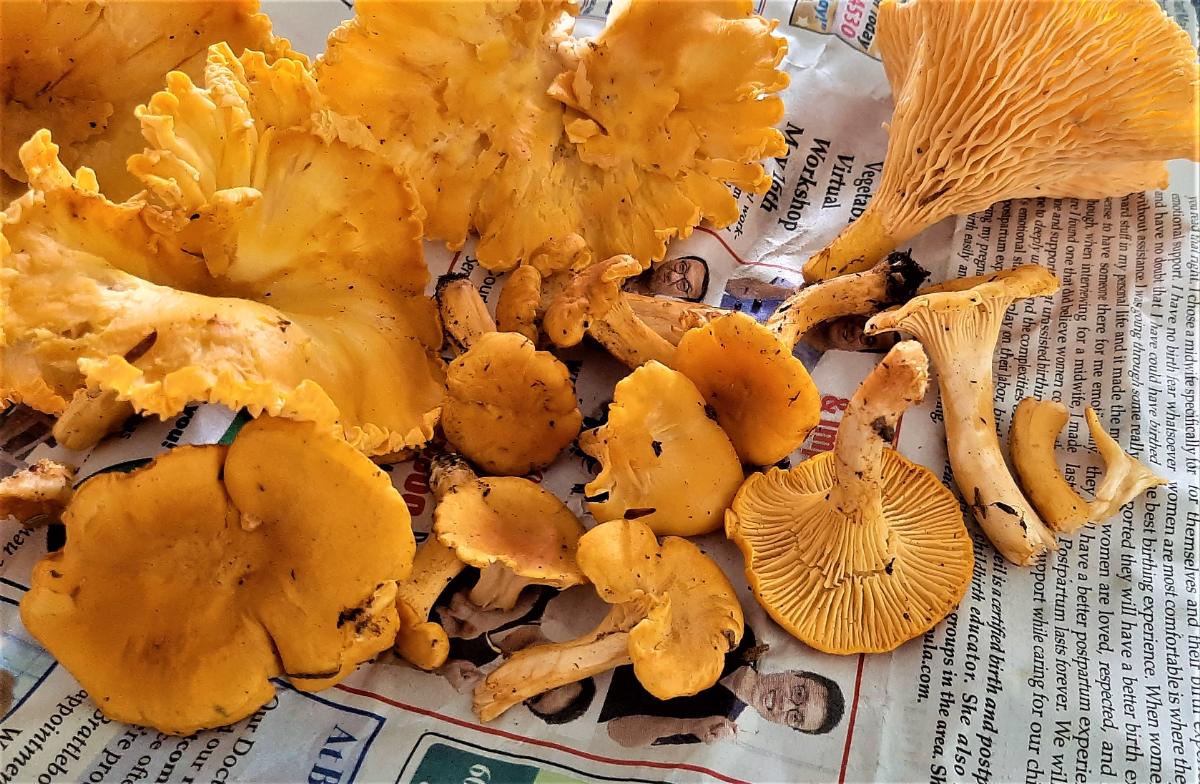
Chanterelles dehydrate wonderfully and can be dried and stored in glass jars for years. Many chefs actually prefer the taste of dried chanterelles, as the flavor amplifies with drying. The dried chanterelles are then used to flavor soup stocks and risottos.
Raw chanterelles don’t freeze well. They become soggy and unappetizing upon defrosting. Cooked chanterelles, though, freeze reasonably well, and this is an excellent quick, easy method for preserving them.
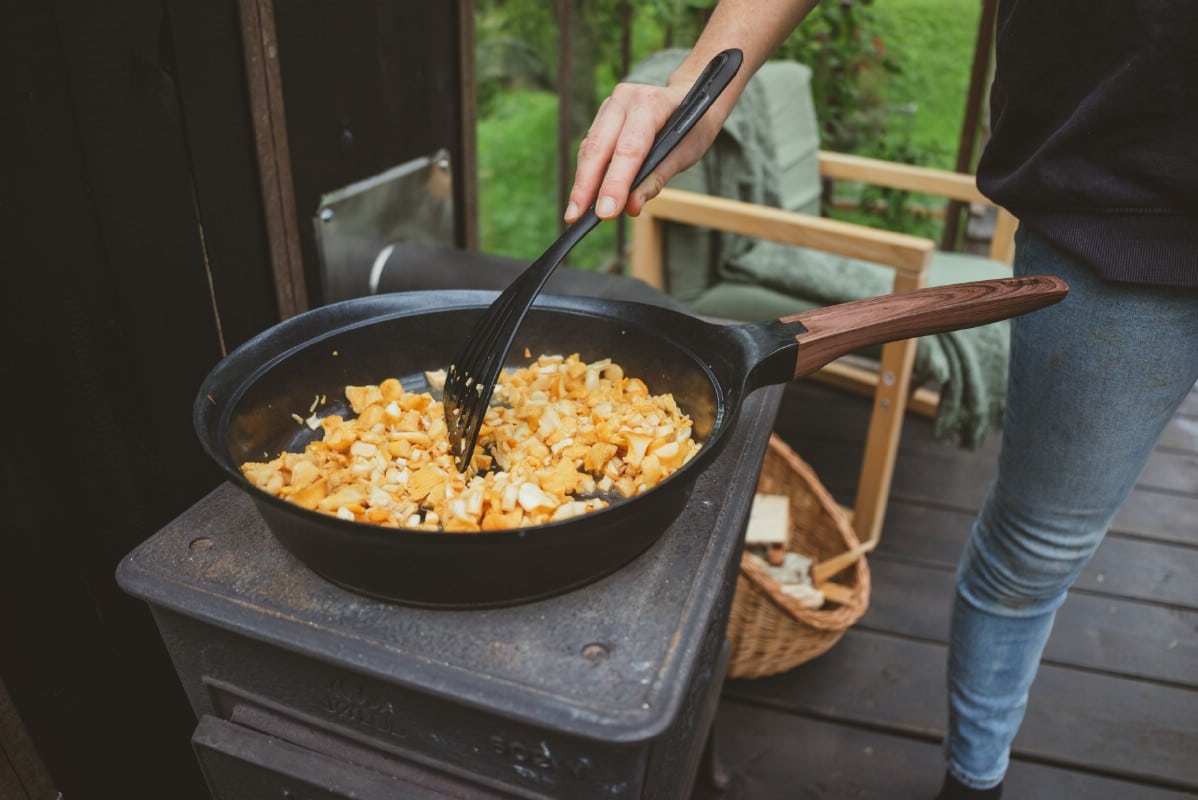
North American Chanterelles
For centuries, foragers have considered the majority of chanterelles found in North America to be the golden chanterelle, Cantharellus cibarius. As it turns out, this is the European species, and recent DNA testing has shown the North American varieties are similar, yet not the same. There is no one overarching chanterelle species in North America like there is in Europe.
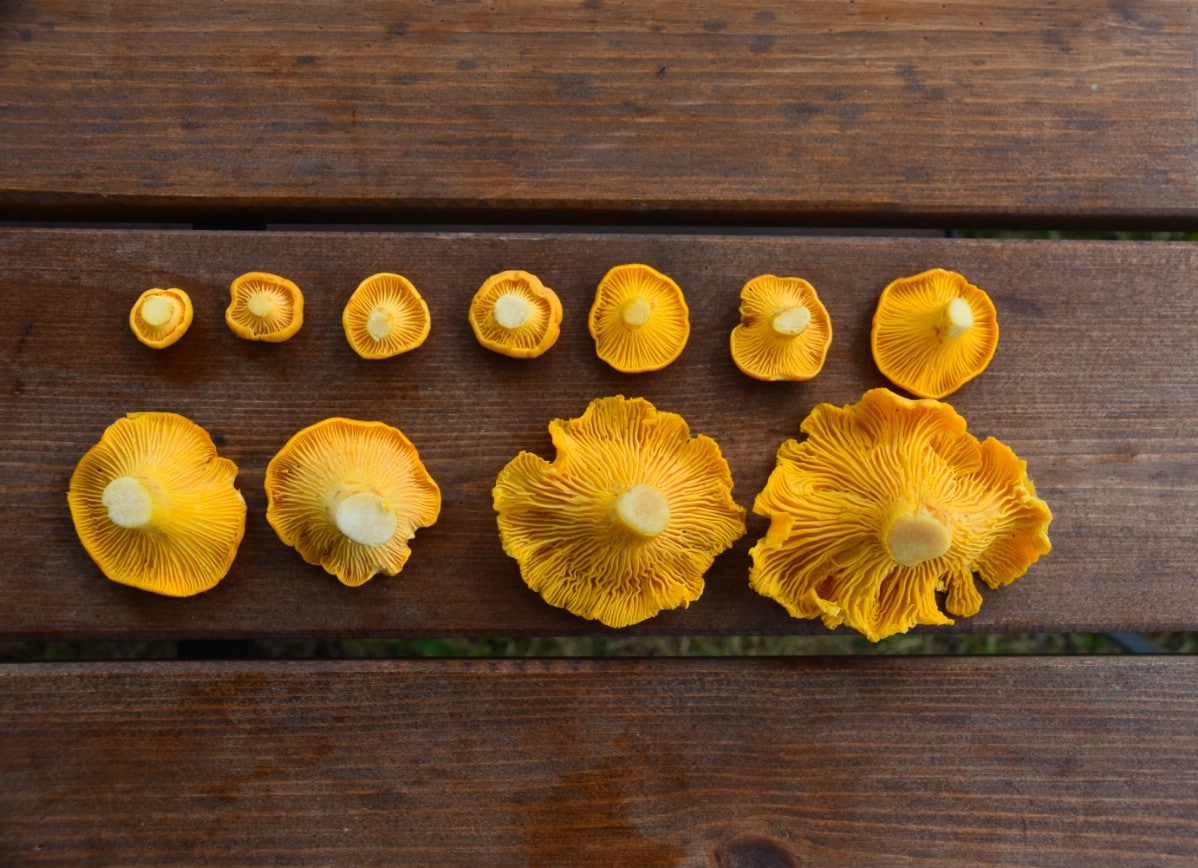
Instead, our forests are filled with dozens of species with similar physical characteristics and growth habits. There are many different “new to science” species, and more are being discovered into the present day. However, for those out foraging, the search hasn’t changed – the golden yellow mushroom that draws us to the woods is still the same, even if its scientific name has morphed over time.
Learn about all the different chanterelles in North America: Red, White, and Golden Chanterelles of the US: Identification Guide
Hunting wild mushrooms, especially chanterelles, is an exciting endeavor and an excellent way to get kids and adults out in the woods exploring. Chanterelle foraging brings the potential of great culinary rewards, but also, even if you don’t find any, it’s a great thing to be out in the woods soaking up all the wonders of nature.
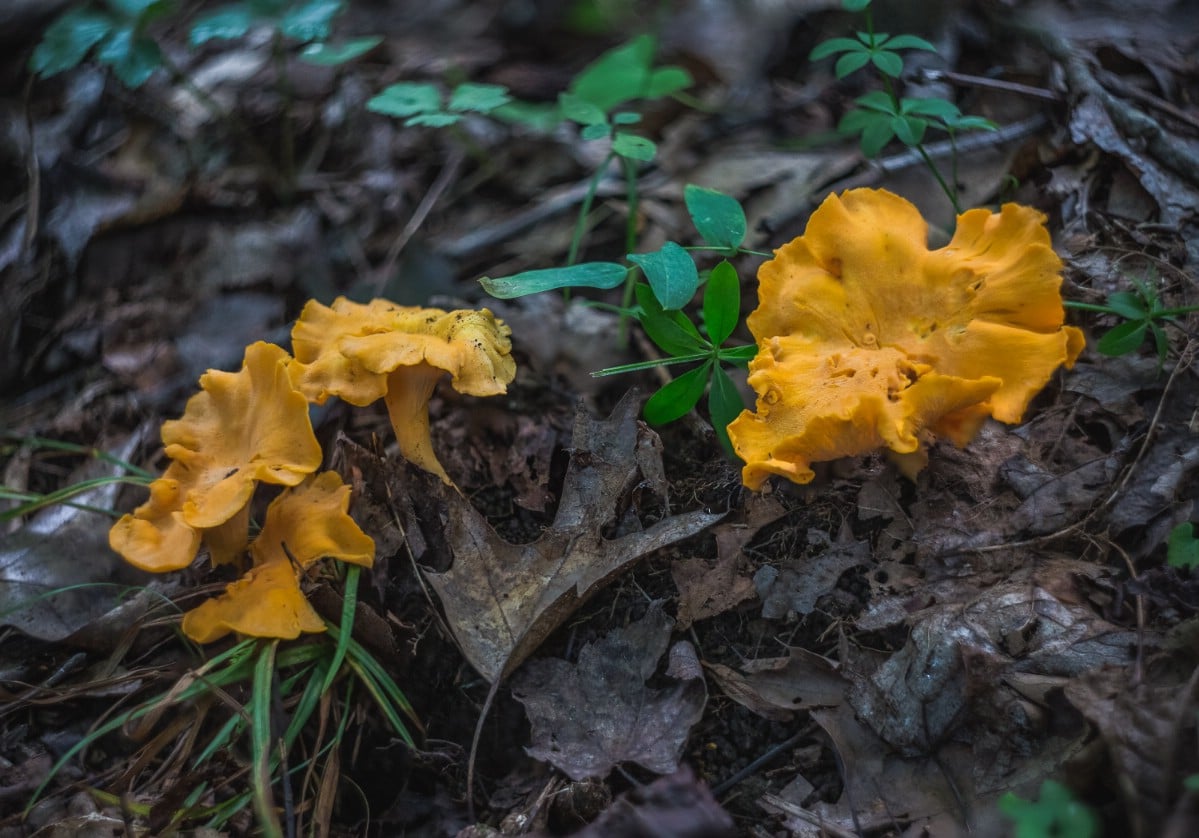
Chanterelle Mushroom Common Questions
What kind of trees do chanterelles grow around?
Habitat varies widely by species. The golden chanterelle usually grows in mossy conifer-prominent areas. But, you can also find them with hardwoods and in mixed forests.
Are chanterelles toxic?
No species of chanterelle is toxic. However, you must be diligent when foraging to ensure you’ve only gathered true chanterelles and no dangerous look-alikes.
When do chanterelles grow?
Late summer through fall is the primary chanterelle season. This does vary by region, though. In the PNW, chanterelles can be a fall and winter mushroom. Also, chanterelles are highly dependent on rains. So, if there isn’t significant rain, their season may get delayed. Or, the opposite might happen – there is so much rain that they appear early.
Can you eat chanterelles raw?
Some people do eat chanterelles raw, but we never recommend it. All wild mushrooms should be cooked to prevent gastrointestinal distress. Raw chanterelles might make you very ill.
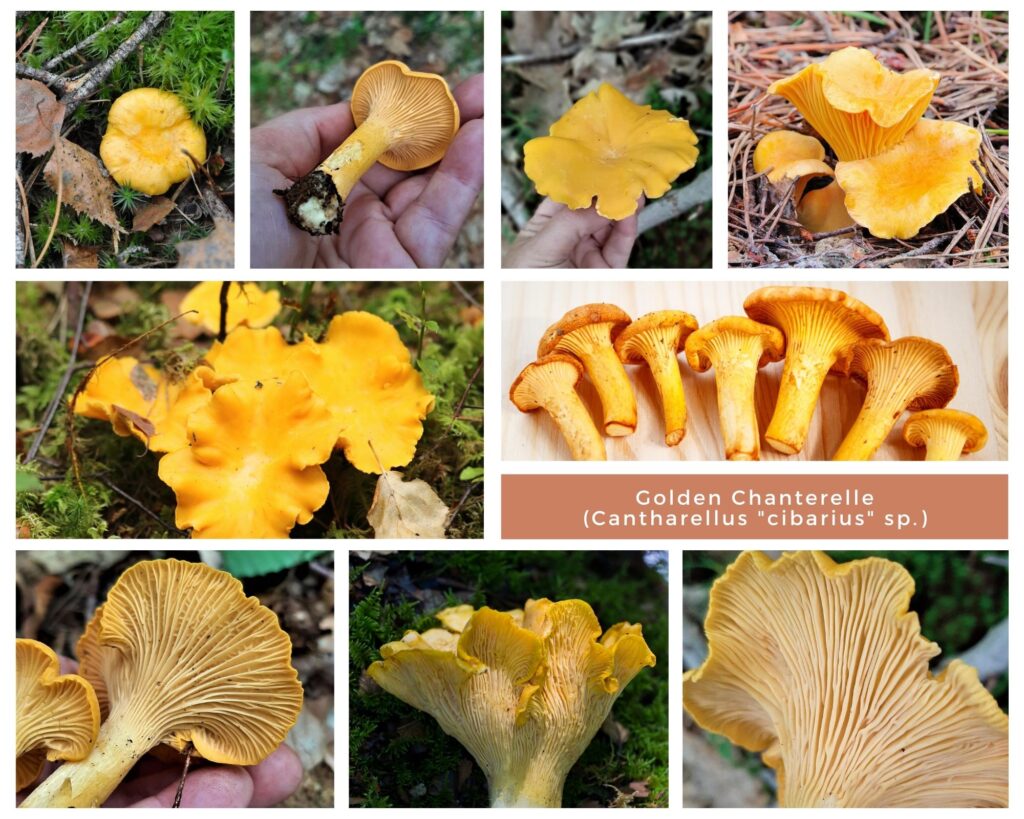

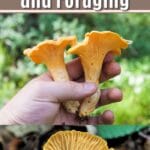
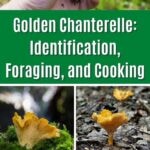
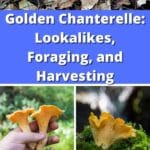
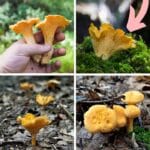

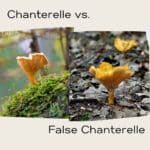
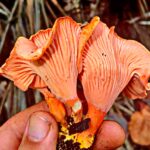
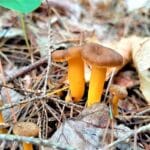
Charlie L
Ok, I picked two false chanterelles yesterday and fried them with wild blewits and eggs today for lunch. Four hours ago. I’m alive and well and not seeing pink elephants. And they did not taste bad or bitter. They tasted delicious. So I’ll be adding them to my short list of wild edible mushrooms I’m familiar with.
Jenny
Oh Wow! Yeah, I wouldn’t worry about pink elephants lol, I’d be way more concerned about your digestive health. They’re considered “not edible” because they cause significant stomach upset. HOWEVER, many people do eat them. In Russia they’re considered edible. David Arora in Mushrooms Demystified says they’re edible. But then there are a bunch of other folks (experts too) who say they’ll make you ill. It’s actually like this with a lot of mushrooms, one source says yes, another says no. Being as I don’t want to steer anyone wrong, I always err on the side of caution. But am always thrilled to hear real reports too! Thank you for sharing this.
Sophie
The 4the photo is labeled as “golden chanterelles” but those mushrooms look like false chanterelles.
Jenny
Yes, sometimes they do look quite alike! You can tell that these are true chanterelles based on the way the gills are wavy and forked and run down the stem. This is an older, a little beat up, specimen, so it may look a bit wonky — i.e. it’s not the perfect looking young chanterelle. Other identification points were used to identify it (this is my own image), including smell, cap color, and habitat. It’s definitely a chanterelle 🙂
Heidi Murdoch
Could you share your email address with me? I would like you to look at the chantrelle mushrooms that I found today in Quebec. They are beautiful.
Heidi
Jenny
You can share photos on our facebook page, I would love to beautiful chanterelles!
https://www.facebook.com/groups/340690111324762
J
I always pick chanterelles in my area of the southeast United States…a big identifier along with the usual traits is a particular apricot smell. Also they tend to be solid white in the middle instead of orange or red colored
Jenny
Yes, that apricot smell is quite distinctive. And, the white middle is a good characteristic, though with some species it is more yellowish than white. But, definitely not red or orange, so a good way to tell apart from problematic lookalikes!
Jody
I found what I think are chanterelles but they have a smoother underside than those pictures. They look 100% exactly like this on top, but smoother underneath…
Jenny
There is a smooth chanterelle – that might be what you have. This guide should help, scroll through the yellow chanterelle species and you’ll see the smooth chanterelle. And also one that isn’t quite “smooth” but has minimal false gills underneath Red, White, and Golden Chanterelles of the US
alf nilsen
I have had pickled chanterelles and they were delisious.
Jenny
Yum!
Blaine Andrusek
At 68 years old, I have been foraging wild mushrooms for most of my adult life, photographing many, and even teaching introductory courses. Until recently, I was missing out on all the medicinal applications. I want to celebrate your site, for both content and overall attitude, providing cautions when appropriate, without scaring anyone away. WELL DONE!!
Blainetheherbman
Calgary, Alberta
Jenny
Thank you! And so happy to hear you find the site useful. Happy foraging!
Hal
We’re in Deep East Texas.
I’m 99% sure I have chanterelles near one of the creek branch bottoms on my property.
Yellow, funnel shaped, the gills look right, white inner flesh, and a definite fruity aroma.
I’m not sure I’d call it apricot, but certainly fruity.
All that being said, I’m still a bit hesitant. I don’t know any mushroom hunter’s in the area …yet…
I think I’ll wait till I find one
Jenny
It’s pretty late for chanterelles. That doesn’t mean it isn’t them, though. You can submit photos to our facebook group to get an ID — make sure to read the pinned/featured post to include all the necessary info https://www.facebook.com/groups/340690111324762
Hal
Your right. I checked, and they’re not there right now. They’re always in the same area, so when they start again, I’ll get some pictures. Thanks!
frieda
I think I found white chantrelles. Can I send you a picture for ID?
Jenny
You can submit photos to our facebook group for ID, please make sure to read the pinned/featured post first to include all the necessary info https://www.facebook.com/groups/340690111324762
Sonja
Hello, I buy white chantrelle from a local lady (we live in eastern Africa), who brings them to me shortly after harvesting. They are always fresh and beautiful. However, there is always white fuzz at the bottom of the funnels and sometimes around the lower stem area. As they are in my fridge (I buy 2kg at a time) the short white fuzz expands up the funnel. The mushrooms remain looking and smelling fine, but fuzz makes me nervous– I think of mold. But this also doesn’t strike me as your typical mold look, nor is there obvious moisture. I’m trying to find out if this white fuzz is just a feature of white chantrelle? Or is it likely to be a mold issue?
I know people here are growing mushrooms in mushroom houses, and therefore these are unlikely to have been harvested in the wild.
I look forward to a response, thank you!
Jenny
Hmmm, it’s hard to say without seeing a photo. Chanterelles do sometimes get a white bloom on them, or it could be spore disperal, or it could be a Hypomyces parasitic fungi infecting the chanterelles. My suggestion is to submit photos (and make sure you read the posting requirements very carefully) to this facebook group, Poison’s Help. Explain the situation and see what they say